Why we ran it: To see if Mazda’s bold claims about its revolutionary Skyactiv-X tech ring true
Month 6 - Month 5 - Month 4 - Month 3 - Month 2 - Month 1 - Prices and specs
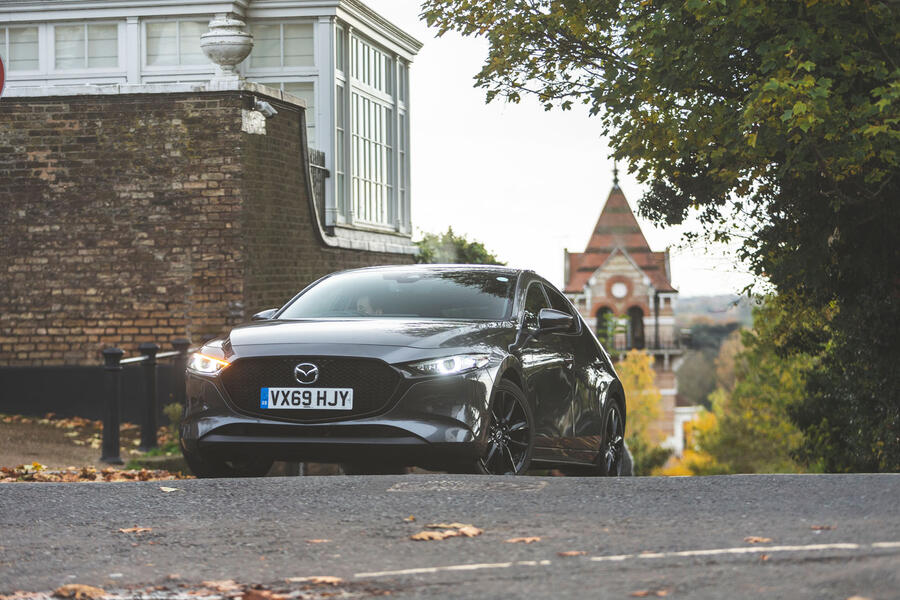
Life with a Mazda 3: Month 6
For its last test on Autocar’s long-term fleet, we pitted our Skyactiv-X car against a lesser-powered Skyactiv-G variant - 15 July 2020
I don’t know about you, but recent world-changing events and the subsequent fallout means that time feels to me like a less reliable construct. Put more simply, nine months ago feels like a lifetime.
The upheaval of both working and social lives during the pandemic meant that I appreciated whatever familiar comforts I could retain. The humble Mazda 3 became one of them, as our loan period quickly became a third longer due to press car operations being shut down.
With the UK under lockdown from mid-March until recently, opportunities to properly enjoy the driving experience became infrequent. But even as a static ornament outside my flat, the Japanese hatchback’s design excellence inside and out meant that just glancing at it out the window, running a sponge over it or using its innards as a quiet, comfortable home office was enough to ignite positivity. I couldn’t say the same about too many other family hatchbacks, and certainly not the competent but unmemorable Kia Ceed I ran last year.
Anyway, with some aspects of life returning to normal and more opportunities to drive, I thought for the 3’s last report I should focus on the question posed more than 8000 miles earlier in the first report: is the new Skyactiv-X compression ignition petrol engine the game changer its marketing suggests it would be? To get a real-world comparison before the car was taken back for good, Mazda kindly agreed to swap it with the lesser-powered, ‘normal’ ignition Skyactiv-G model for a week.
There’s essentially no external difference between Skyactiv-X and Skyactiv-G cars aside from subtle badging changes. Significantly, both feature sporty-looking twin tailpipes. That similarity remains on cold start-up, where both jump to a high (and loud) idle for a minute as part of Mazda’s accelerated warm-up system to bring the catalytic converter up to its most efficient operating temperature. But once that minute was over, I found that it’s the lesser Skyactiv-G that settles to a smoother, more distant hum. The Skayctiv-X is more evident, a little rougher – although not obtrusive.
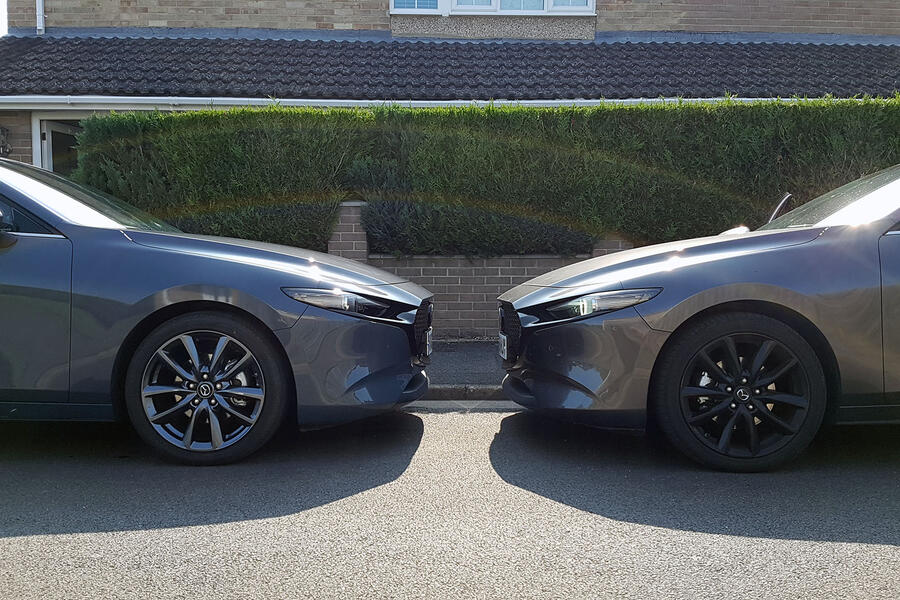
The refinement differences were more apparent on my jaunts outside town limits. Both transmitted less vibration through the main controls than many of the three-cylinder turbo engines I’ve tried in rivals, but our X is particularly rattly and vocal (almost diesel-like) below 3000rpm. The G sounds that bit more cultured to me.
Interestingly, despite the 58bhp output deficit, the G didn’t feel an order of magnitude slower in the sort of medium-speed, about-town traffic I usually find myself in these days. My long-termer has a mere 8lb ft torque advantage over the newcomer. It’s only when you stray above 3000rpm – when the X hits its torque peak and the G still has another 1000rpm before it does the same – when the higher-powered 3 starts to pull out an advantage. That grows ever greater the harder you rev it; neither particularly thrives on high revs, but the G tails off noticeably as you approach 5000rpm, whereas the X still has a fair bit left to give.
The on-paper advantage for the latter is significant (a 0-62mph time more than two seconds faster and a 12mph higher top speed), yet I found both engines needed to be kept on the boil, and inclines mean frequent downshifts. And, frankly, that’s not quite as pleasurable as it sounds, despite Mazda’s classically slick manual shift. Whereas the engine in, say, a Mazda MX-5 seems to actively encourage you to stretch it out, I found that the Skyactiv-X’s economy-biased gearing, occasional flat spots and so-so soundtrack didn’t make me relish reaching for the redline.
Both cars also use a 24V mild-hybrid system (not 48V as I mistakenly reported in a previous issue), allowing for more effective stop-start and a bit of off-the-line electric assistance. Our car hovered around the 43mpg mark throughout its time with us, while a week with the lesser-powered 3 yielded a trip-indicated 42.2mpg. That’s not strictly comparable given the difference in journeys undertaken, but I still reckon the X would prove more economical in the longer term. Even if it would be a long time to recoup the approximately £1500 list price difference at the pumps, the extra power is useful.
Overall, I’m left feeling that the X engine’s clever engineering isn’t as transformative as I had hoped, however. The performance advantage is welcome but not profound. And while our overall economy figure is very respectable for a naturally aspirated motor of this output, many turbo motors with less peak power (Volkswagen’s excellent 1.5 TSI springs to mind) deliver similar frugality and substantially more low- to mid-end punch than either engine.
That said, I’ve enjoyed my time with the 3. It’s becoming more of a common sight on the roads but still draws admiring glances, even from owners of much more expensive metal. The interior remains my favourite of any mainstream C-segment car, and concerns over practicality have rarely posed a problem for my usage. And, engine aside, the 3 manages a strong balancing act between driver appeal and passenger/long-distance comfort. I’ve no doubt that it’ll remain in my mind as I move onto my next (rather different) long-termer.
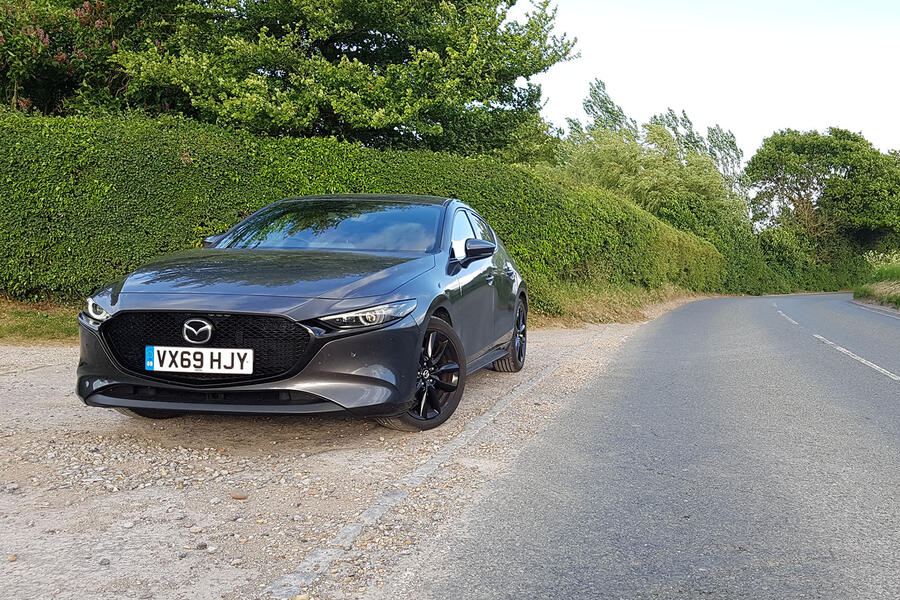
Second Opinion
Providing a sense of occasion isn’t a prerequisite for success in this segment, but there’s a lushness to the 3’s interior that’s hard to ignore. Our car’s oxblood seats won’t be for everyone, but the expansive centre console, sweeping dashboard and subtle chrome embellishments make it feel bigger than it has any right to be and more special than the mainstream equivalents.
Felix Page
Love it:
Design When even BMW and Audi drivers are craning their necks to get a look, you know Mazda is onto a winner.
Interior Hugely roomy it isn’t, but ergonomically sound, materially plush and attractively designed it is.
Controls I can’t recall a family hatchback with nicer steering or a gearshift that’s more enjoyable to operate.
Loathe it:
Windows Global window opening/closing via the key is a boon on hot summer days. You can’t do this with the 3.
Centre trim The gloss black trim around the gearlever is very easily scratched and shows up marks quickly.
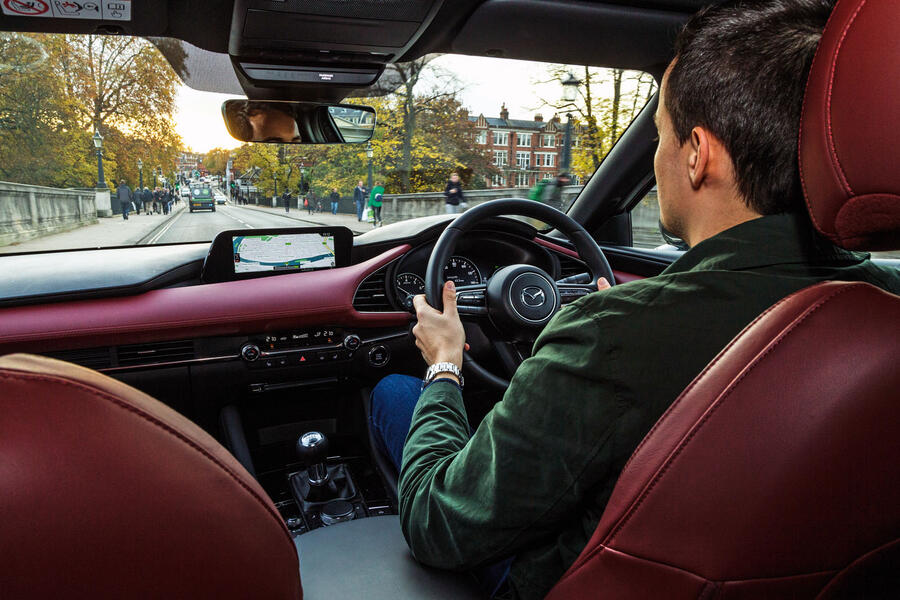
Final mileage: 8946
Life with a Mazda 3: Month 5
Cruise control complaints - 20 May 2020
An industry colleague and friend spent some time in a Mazda 3 pre-lockdown and declared its adaptive cruise control “atrocious”. He may have sworn a bit, too. I’m unable to evaluate that for myself at the moment, of course. I’ve always switched to standard cruise control when possible, because I find the way these systems react on busy British motorways deeply irritating and believe they encourage inattentiveness and poor lane discipline. But he tells me the 3’s has a habit of slamming on the brakes, thinking something is entering the lane when it isn’t: probably the worst trait imaginable. Maybe it’s a one-off, but I’d like to hear from any owners who have experienced the same.
Mileage: 8104
The judges say it’s the best-designed new car in the world – and its keeper agrees - 13 May 2020
You’ll have to forgive me for banging on about the design of our Mazda 3 once again, but with precious few miles covered in it since the last report, it remains more of a street ornament than a car. Although I also have a good excuse for bringing it up this time, as last month the humble hatchback was named World Car Design of the Year by a panel of judges that included our own Richard Bremner.
It’s not the first time Mazda’s design department has been singled out in the awards: the latest MX-5 picked up the same gong in 2016. However, it’s rare for a C-segment hatch to be crowned. The last one was the Citroën C4 in 2006. Jaguar Land Rover has had much success here recently, with the Jaguar F-Pace, Range Rover and Jaguar I-Pace winning the last three years respectively.
But I’m in total agreement, especially given the relative lack of inspiring car designs over the past 12 months. The 3 is one of those cars where it takes time to fully digest and appreciate its shape and detailing, and recent good weather has also highlighted the way light reflects off its curved surfaces, particularly from the side. It has actually led to a number of comments, from readers and colleagues alike, whose eyes have fooled them into thinking the car has huge dents in the doors. Some may not be a fan of that, but all the best designs should have an aspect that challenges convention.
Anyway, a few weeks after the Mazda’s gong, a tweet caught my eye from Spanish designer José Antonio Aranda.
A drive to get medication makes the most of the quiet roads - 22 April 2020
I was fortunate to be able to visit the pharmacy recently. Not a sentence I expected to utter but, because I moved away months ago and stupidly forgot to register at the nearest doctor’s, obtaining a specific prescription involved a 32-mile round trip back to my home town.
Post-lockdown, it’s the longest drive I’ve had in nearly a month, and as it fulfils the ‘essential journey’ criteria, I don’t have to feel too guilty. The quiet roads meant I chose the more scenic cross-country route, too.
Doing so was a luxury, and one I won’t do again under lockdown. Many still believe they are entitled to drive wherever they like as long as they don’t meet anyone, but if even a small percentage of those joyriders have an accident or breakdown, they are tying up emergency services needed for key workers who still have to drive to work every day. Judging by the number of leather-clad folk on superbikes that couldn’t even carry a toilet roll back from the shops, that message still hasn’t got across.
Anyway, rant over. The excursion reminded me of how close to the top of the class the Mazda’s driving experience is. The suspension control, steering and gearbox action are top notch. Yet it’s pinned back by an engine whose long gearing and anodyne soundtrack fail to inspire.
I also took the opportunity to do a supply run for my parents – staying outside the house – with the ulterior motive of taking my bike from their garage back to my flat. The 3 might be one of the least practical in its class but it swallowed the bike with ease and, as it’s not an SUV, the low loading lip made lifting it in far easier.

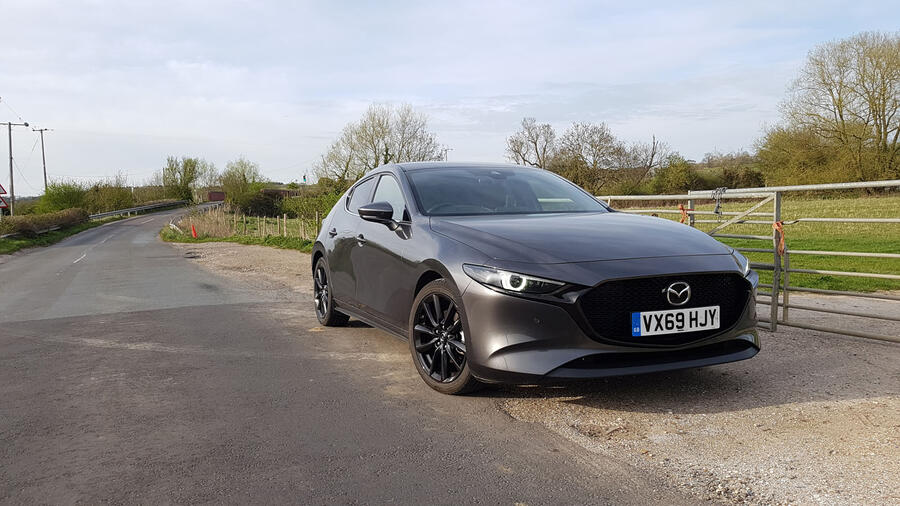
Mileage: 7834
No better time for a clean - 15 April 2020
With the Mazda becoming in effect a garden ornament for the foreseeable future, I took the opportunity to make it a clean and sparkly one at the very least. I’ve not had the time for handwashing cars of late but, with few opportunities to drive the Mazda, it seemed the perfect chance to dust off the bucket and sponge as another way of interacting with it. I’d forgotten how therapeutic car washing can be, and it’s particularly enjoyable with the svelte lines and tight panel gaps of the Mazda. The metallic grey/gloss black contrast can’t be appreciated with a layer of grime.
Mileage: 7781
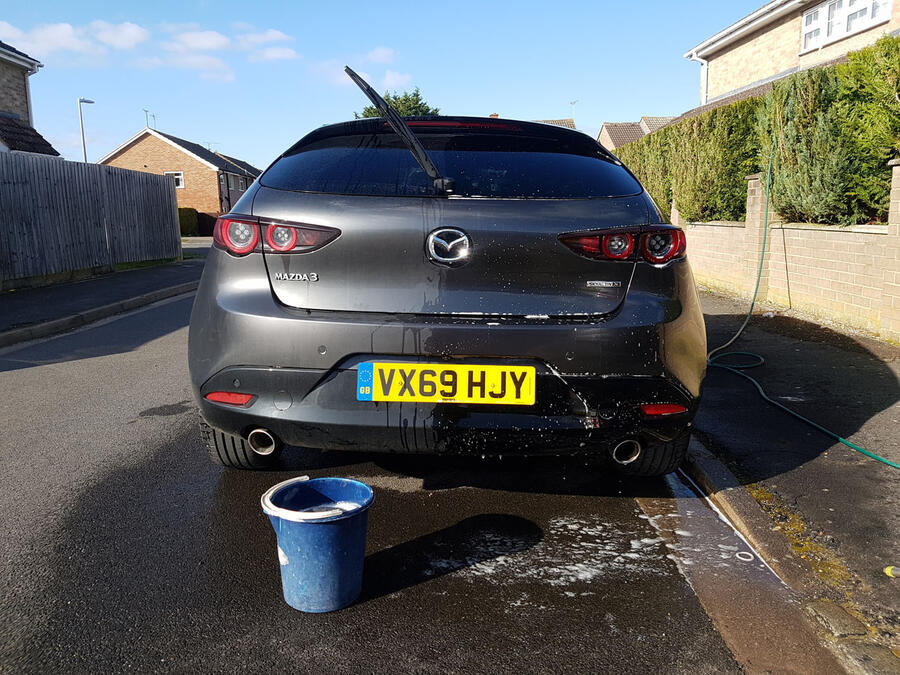
We compare two cars that are both easy and hard to separate - 1 April 2020
All mainstream family cars are basically the same, right? That’s what some of the more outspoken (read: cynical) voices within the motoring media and wider industry would have you believe.
This is a view that appears to have been amplified as the march of electrification gathers momentum. But, actually, many manufacturers have distinctly different approaches to the phenomenon, and these numerous strategies end up creating more motoring variety as a result. Deputy editor James Attwood and I are running a pair of long-termers that illustrate this point perfectly.
Both are Japanese, they are similarly priced, they offer broadly comparable on-paper performance and each features a hybrid powertrain. But the difference between the two cars is quite stark in reality, so we thought that a brief swap would be in order.
Toyota has been at the forefront of hybridisation for a couple of decades now, and that experience pays off in the latest Toyota Corolla. Having undergone several iterations, its latest Atkinson-cycle petrol hybrid CVT system balances power and economy better than ever, thanks to much more electrical assistance than older systems; it can now switch to electric-only cruising at up to 70mph, for example.
It’s perfectly suited to Attwood’s town-centric commute. So much so that he prefers it to the highly praised Ford Focus he ran previously, citing the Corolla’s smoothness, relaxation and fuel-sipping parsimony as nigh-on unbeatable. But my commute couldn’t be more different: a mile or two of town work a day combined with 80 more on motorways and dual carriageways.
Switching between the Toyota and the Mazda, they couldn’t feel less identical if they tried. To look at, the 3’s svelte profile wins out for me, but the Corolla is far more visually desirable than the dour Auris it replaced. Inside, too, Toyota has upped its game in the perceived quality stakes, but the ambience and general usability of the Mazda’s stylish and solid yet intelligently laid-out cabin gives it the edge. The Corolla’s cheap-looking, fiddly infotainment is a particular bugbear.
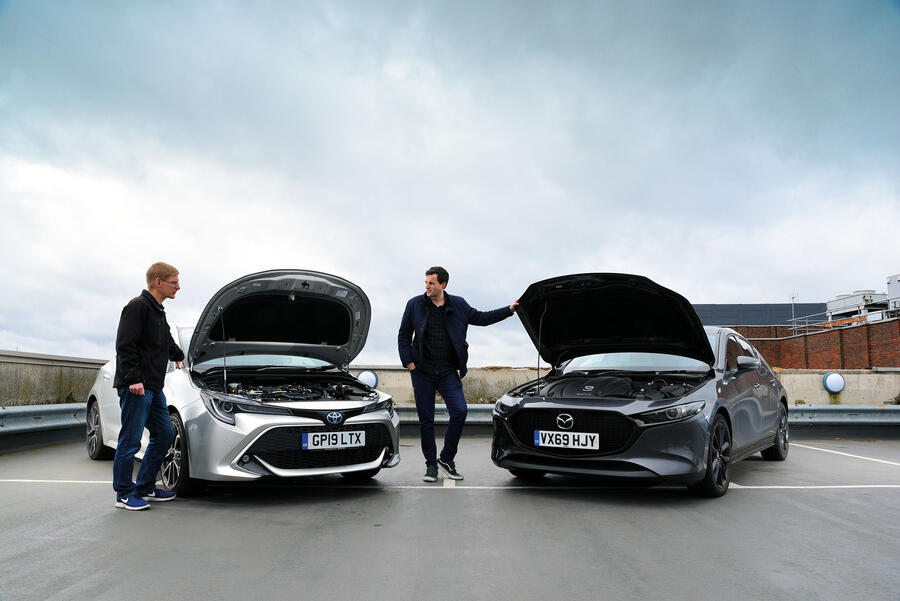
It’s clear from the first mile, unsurprisingly, that the Mazda’s comparatively weedy 24V mild-hybrid system is no match for a full hybrid in engine-off running. Whereas the 3’s electric mode only operates when coming to a stop at a junction or traffic queue, once the Toyota’s system is warmed up after a couple of minutes, it manages to keep the engine off around 90% of the time in my five-mile journey from our office to the mouth of the M3.
From that point, the Corolla’s petrol engine stays on for most of the journey, but it still works out around 10mpg more efficient (possibly more) on the motorway than the Mazda. It’s also nowhere near as sluggish as you’d expect, actually feeling quicker than the 3 when accelerating at low speeds thanks to a surfeit of electric torque and the lack of gears to change.
The Mazda is in a different league for driver involvement, however: keeping the torque-lite motor on the boil using the slick six-speed manual is more rewarding, and while the Corolla’s steering is surprisingly natural and direct, its switch-like brake feel and softer suspension set-up mean it’s less confidence-inspiring when you up the ante.
So, it’s a classic case of head versus heart with these two. The Toyota works better in a city, it’s roomier inside, it rides a bit more smoothly and it’s more frugal. But despite the Mazda’s deficit in the sensible areas, its desirability and driver appeal are serious pull factors.
Love it:
Classy cabin The 3’s interior blends form and function better than anything else at this price.
Loathe it:
mediocre MPG The Corolla really shows up the 3’s underwhelming fuel economy. It’s barely better than that of torquier turbo petrol units from rivals.
Mileage: 7720
Life with a Mazda 3: Month 4
Mazda earns another fan - 18 March 2020
Former Autocar road tester and current bloke on telly Chris Harris recently called the Mazda 3 “the most interesting looking and sounding family car to launch in the past year”. From somebody who doesn’t hold back his distaste for many modern cars, that’s some praise. I have to agree: few models in its class look and feel so special.
Mileage: 7432
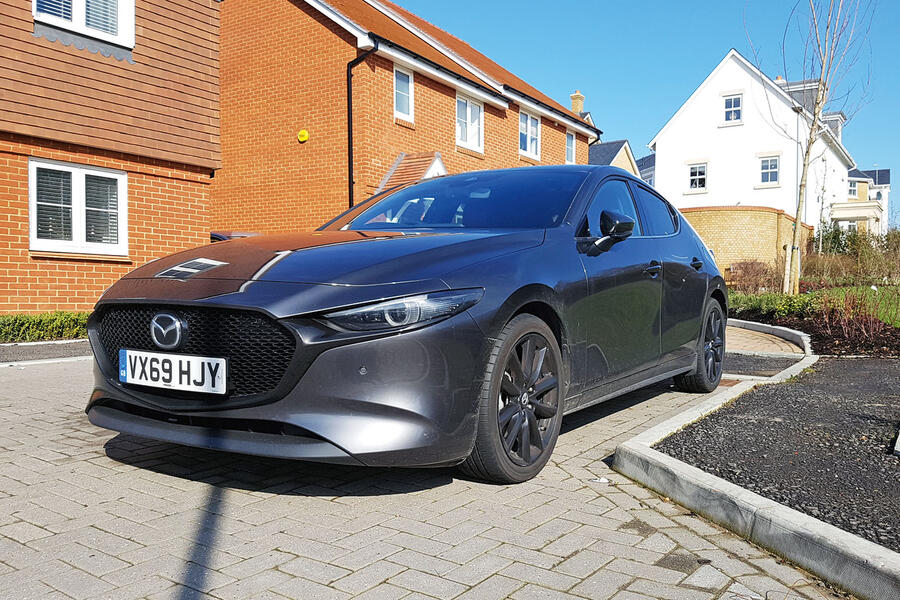
Uncovering useful infographics - 11 March 2020
The mild-hybrid (MHEV) Mazda 3 has a display that you get on full-hybrids, showing the juggling of battery and motor – although the battery can never solely propel the car. The most interesting MHEV trait is a little boost when upshifting. The display also tells you when you’re in compression ignition mode, which it usually claims to be until about 5000rpm.
Mileage: 7230
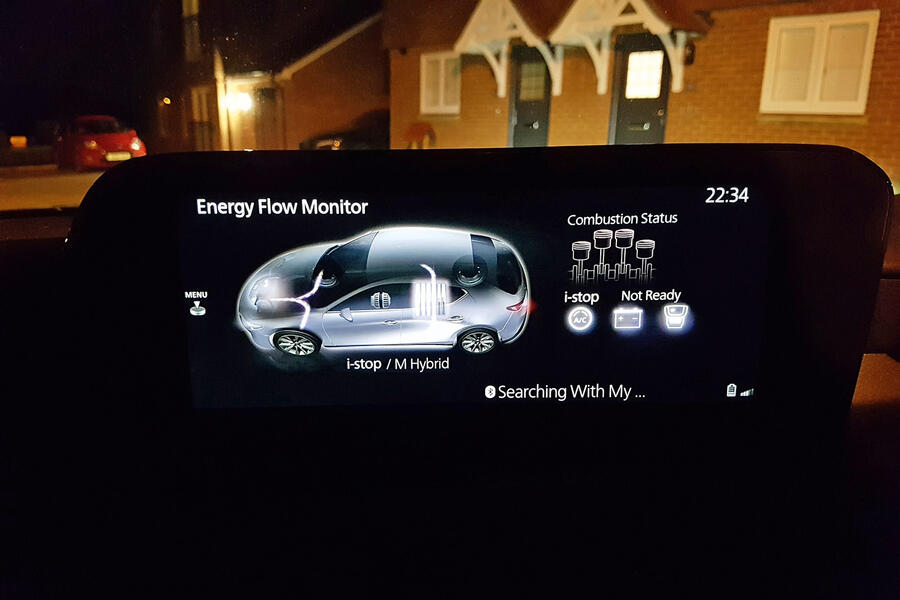
Life with a Mazda 3: Month 3
It’s got the look - 19 February 2020
A few weeks ago, I caught one of my neighbours ogling the 3 for a good while. He’s now got one on his drive. Desirability sells and, from the looks I’ve been getting, the svelte Mazda can be flogged on that alone. It got me thinking: with sub-£30k coupés all but dead, this is probably the closest you can get to something like a VW Scirocco these days.
Mileage: 6446
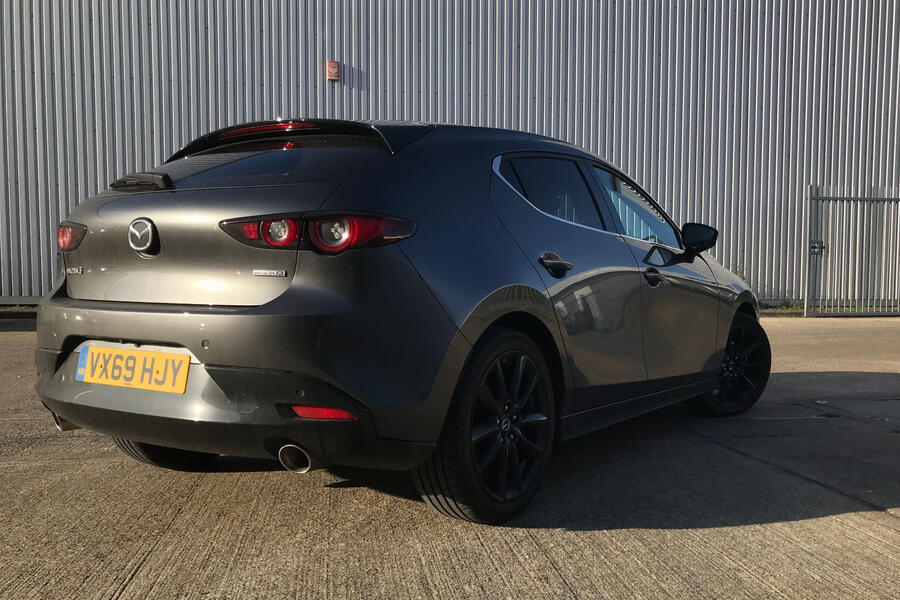
A comparison with the high-rise, but similar, CX-30 is revealing - 12 February 2020
Gone are the days when a new car competed with three or four core rivals in the same class.
Ever-expanding ranges and niches that don’t remain so for very long mean most mid-sized metal is cross-shopped between two or more car categories now – even within one brand itself.
So when the the similarly sized, priced and positioned Mazda CX-30 crossover hatch-cum-SUV was launched, we thought there was plenty of merit in living with it for a week to compare it with our long-term 3. And indeed there was.
The maker hasn’t gone to great lengths to disguise the CX-30’s platform relation. The design similarity is clear, though to our eyes the crossover trades a good chunk of the hatchback’s tight proportions and clean elegance with the adoption of plastic body cladding and a more upright stance. Interestingly, instead of making the SUV variant bigger as is usually the case, it’s actually 70mm shorter in length than the 3. Mazda claims this, along with the higher driving position, makes it easier to manoeuvre around town – and we’d agree with that claim.
An unsurprising negative, however, is that rear seat space suffers. Given our 3 isn’t exactly generous in rear proportions, the significant leg-room reduction means a six-footer would look decidedly glum squeezed behind the driver. In all other respects, the interior is faithful to our 3: smartly styled and intuitively designed. In fact, there’s very little from the inside to make you think you’re in a high-riding variant – the driver’s seat sits an inch or so higher, if that.
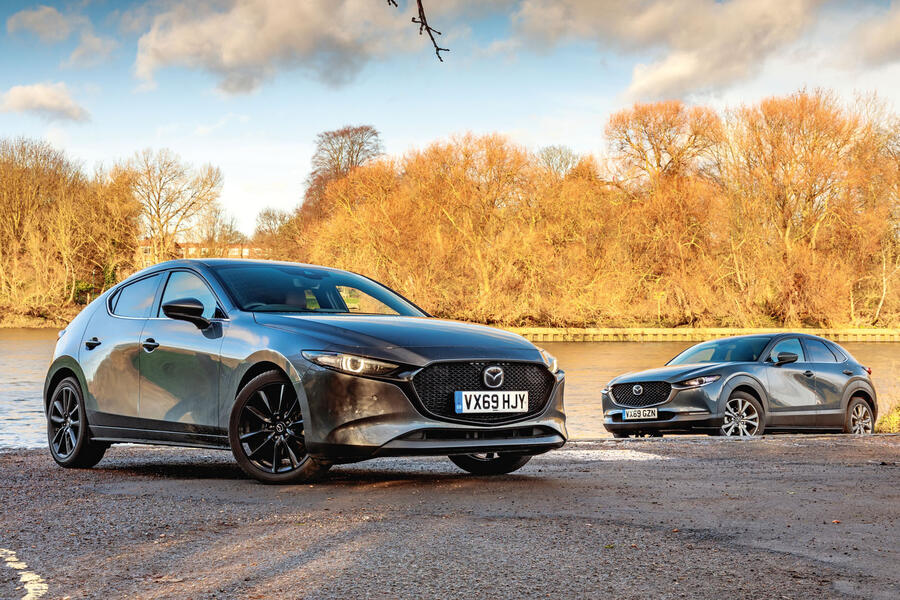
Mechanically, there’s little difference. Both cars are powered by the 178bhp Skyactiv-X petrol engine, although the CX-30 here features all-wheel drive (also optional on the 3). With a relatively slight 57kg weight penalty (add 71kg to that for the all-wheel-drive car), performance feels broadly similar, and indicated fuel economy on our week-long test managed to match our 3’s figure, despite the all-wheel drive.
But there’s a distinct difference in the dynamic character of the two cars. Unlike some makers who feel the need to stiffen up the SUV version to counter for the higher centre of gravity, Mazda seems to have relaxed the CX-30’s spring rates, meaning a softer ride in combination with squidgier, larger-diameter tyres. It’s more comfortable over pitted Tarmac than the 3, but the tradeoff is floatier body control and a reduced feeling of agility and composure in the bends.
Would I have the CX-30 over the 3? Personally, no. I enjoyed it, however, and there’s no question that it’s one of the more engaging and characterful cars in its class, but the lower, lighter and (crucially) far prettier 3 always wins out for me.
Back to the 3 itself, which was in the wars before Christmas after contact with a particularly brutal pothole. It actually knocked the steering wheel off-centre, so we had to take it to a tyre fitter to get the alignment sorted. While that straightened the tracking out again, it didn’t do much to fix the background humming noise from the front tyres between 40mph and 65mph. Our hunch is that we lost a wheel weight in the impact, so we’ll have to book it in again to get that sorted. In the meantime, we’ll be using that age-old temporary fix of turning up the radio a bit.
Love it:
Goes like it looks The 3 is, to our eyes, far prettier than the CX-30, but it’s also more fun to drive. We know which one we’d pick.
Loathe it:
Hard over potholes The CX-30’s softer set-up would’ve been likely to cushion the impact of the damaging pothole more.
Mileage: 5979
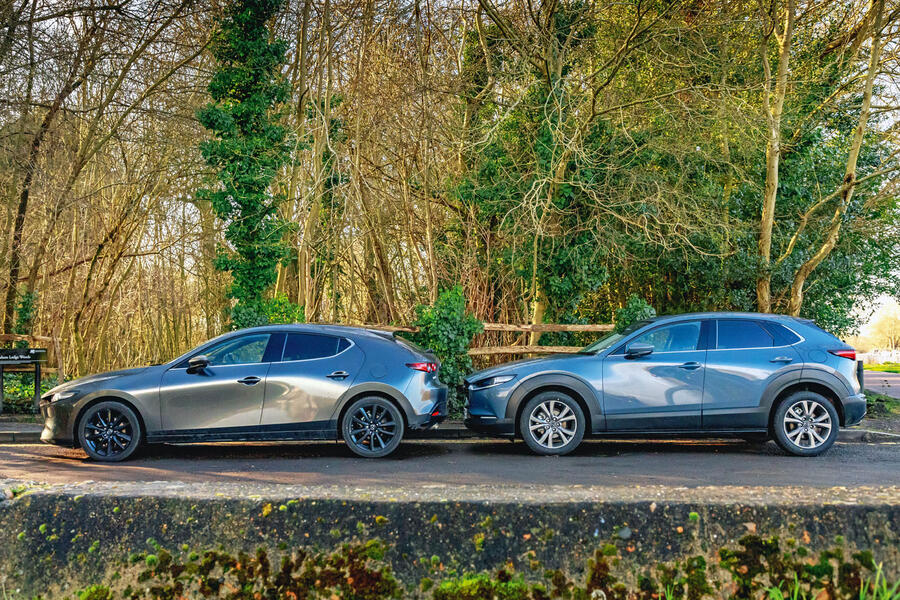
Life with a Mazda 3: Month 2
Mazda’s instruments hit all the right notes - 15th January 2020
You can tell Mazda is run by car enthusiasts, not bean counters. It’s evident in details such as the 3’s instruments, which are superbly clear and legible. There’s a traditional engine temp gauge, too, and I like the fuel range warning. When it drops below 20 miles, the ‘miles to empty’ counts down one mile at a time. Perfect for those of us who relish a bit of fuel light bingo.
Mileage: 4709
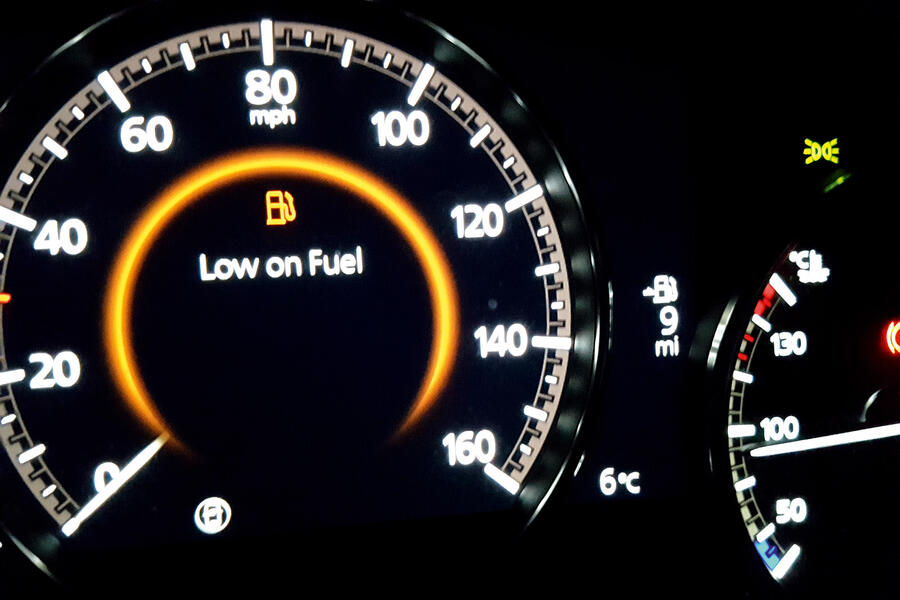
Our car has an uncanny knack of humiliating its driver - 8th January 2020
Having now recovered from my learner driver stalling tendencies detailed in my last update (I haven’t stalled the Mazda in weeks), I’ve now plumbed new depths of idiocy by managing to run the 3’s battery flat not once but twice in the space of two weeks.
The first time I was confused. Walking towards the car on my way to work, I reached for the handle to activate keyless entry, but nothing happened. A tap of the button, not a sound. My first thought was a dead key battery or locking issue, so I prised out the physical, emergency lock key, which is surprisingly tricky to slot into the door and use.
On discovering that the interior lights didn’t work, too, I realised exactly what had happened. After an apologetic ‘I’ll be late’ message to the boss, I called Mazda assist, who arrived within the hour with some jump leads (I’d just moved house and left mine behind). It turned out I’d somehow nudged the light stalk switch from auto to sidelights when getting out the night before and not noticed.
Amazingly, I did it again not long after, but this time I was prepared with a portable jump starter. I was feeling particularly sheepish until my colleague informed me he’d done the same with the Mazda. I then learned from Twitter that a few others had had a similar experience with 3s on test. The culprit? Everyone agreed the ‘lights on’ buzzer was far too quiet to be noticed. Given how clever car systems are these days, it’s amazing the car doesn’t know the battery is running flat and kill the lights itself.
Anyway, with these episodes behind me, I’m settling quite comfortably into life with the svelte Mazda. Despite a layer of winter grime and a less than distinctive paint job, it still draws admiring glances, but it’s the cabin that does it for me. I think it’s a best-in-class combination of fit and finish, simplicity of operation and design nous. Cold weather has uncovered a couple of light rattles, but it’s an early production model and I’ve driven far pricier stuff of late with worse interior noises.
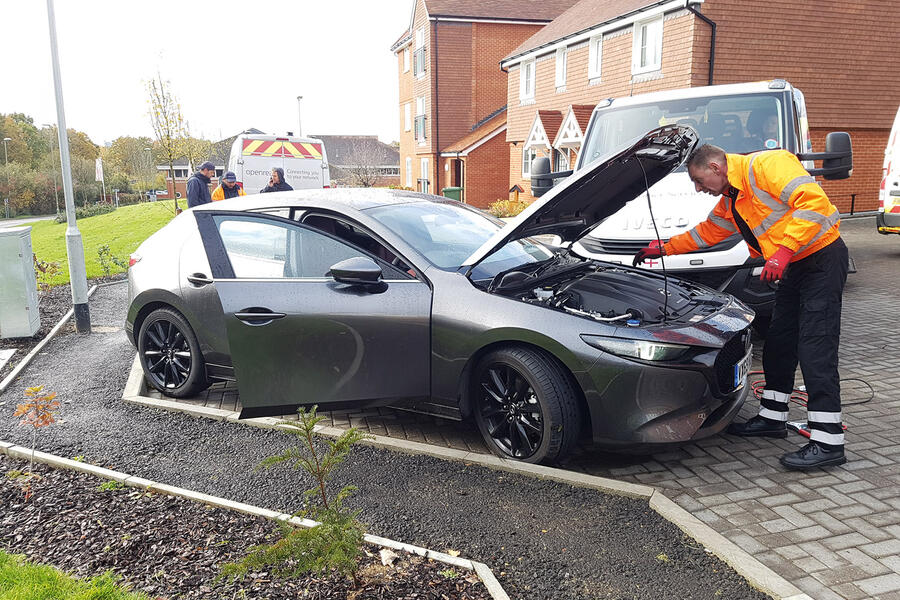
Despite being full of praise for its design, I can’t help feeling a touch underwhelmed by the much-lauded Skyactiv-X motor. Economy hovering around the 43mpg mark is respectable but not exceptional given my motorway-heavy commute, but my issues are more with refinement. I love a good engine note as much as the rest, but the 2.0-litre unit’s gruff tones between 2 and 4000rpm (ie where you spend most of your time) can grate on occasion, with a diesel-like knocking noise sometimes rearing its head on part-throttle.
I’ve also had a request from a reader to comment on the 3’s torsion-beam rear-axle set-up, which he describes as “cheap and nasty” compared with the previous car’s independent rear. It’s a fair (if strong) point, but unfortunately it’s increasingly becoming the norm: even Mercedes’ A-Class comes so equipped in lesser specs, and Ford’s latest Ford Focus is (as of last year) torsion beam only on everything except the 2.0-litre diesels. They are not only cheaper to make but far more space efficient.
Is it a negative for the Mazda? the Not according to our road test of this very Mazda 3, which praised its handling and found minor fault with secondary ride comfort, likely due to the larger, 18in wheels.
Love it:
Infotainment Touchscreens are so 2019 – a well-executed rotary click wheel like this is infinitely more intuitive when you’re driving, and the menus are a doddle.
Loathe it:
Engine noise Pleasant at higher revs when you do want to hear it, but too gruff at lower revs when you don’t. More sound deadening, please.
Mileage: 4192
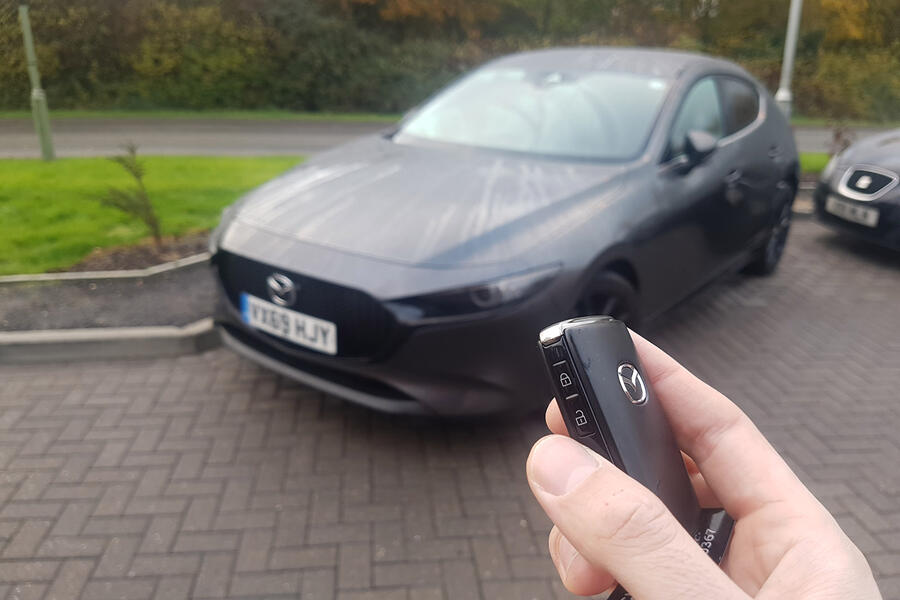
Life with a Mazda 3: Month 1
Like being a learner again - 4th December 2019
That feeling of embarrassment at stalling at a junction has returned with the 3. It was happening daily at first, and I breathed a sigh of relief when I found out other colleagues had suffered the same indignity. A slightly abrupt clutch action aside, most of the blame can be placed on us for being so used to the low-down grunt of turbo motors.
Mileage: 2850
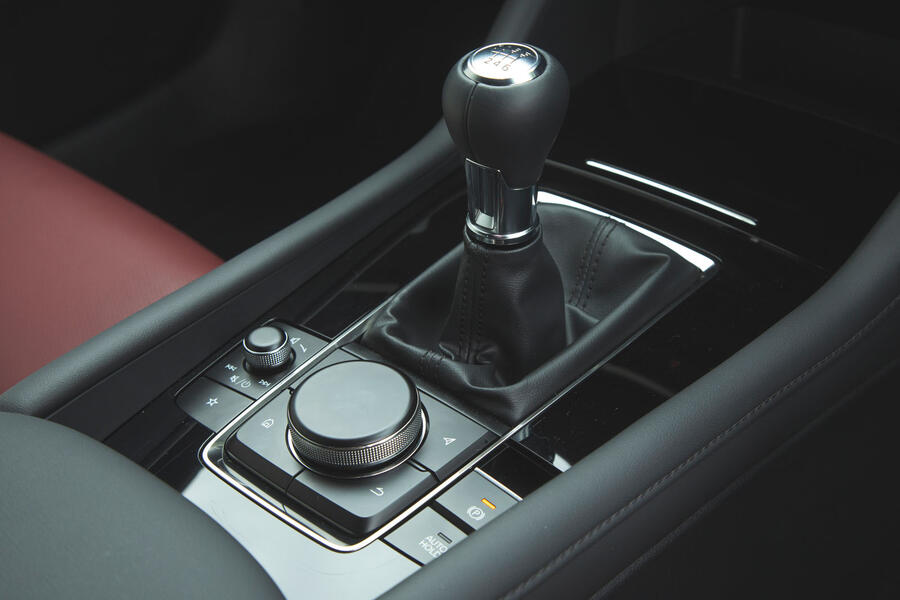
Welcoming the Mazda 3 to the fleet - 27th November 2019
It’s generally been accepted for several years that, bar the odd bit of fiddling, combustion engines have largely peaked in terms of internal development. So when a company came along claiming a genuine innovation, we sat up and took notice. So much so that a first drive or week-long loan wasn’t sufficient: we needed to see this car’s ability to perform in a variety of scenarios over a longer period.
That car is Mazda 3. Yes, as you’ve likely read if you regularly thumb through this magazine, the humble, rather left-field hatchback is the first model from the humble, rather left-field Japanese brand to make use of its groundbreaking Skyactiv-X engine tech. While six months is hardly a full verdict into its long-term reliability, we’re hoping to uncover the good and the bad of this innovative system (and the car it’s attached to) as the miles pile on. And pile on they will, with the 3 pushed into service for airport runs, long-distance trips and – more regularly – my 80-mile round-trip commute.
Missed all the fuss about Skyactiv-X? Well, here’s a brief explanation. The engine uses something other manufacturers have been unable to perfect for decades: compression ignition (like that used in the diesel combustion process) of petrol. Under light loads, a lean fuel and air mixture is pushed into the cylinder under a very high 16.3:1 compression ratio. It won’t ignite like this alone, however. So as the piston compresses the lean mix, a small amount of a richer fuel mixture is squirted towards the spark plug.
As this ignites it increases pressure further, in turn igniting the leaner mixture filling the cylinders, burning it more cleanly and efficiently. Give it the beans, however, and the system switches to a conventional petrol combustion process.
To achieve this the Mazda makes use of a supercharger, but that isn’t there for the power gains – simply to supply enough air to keep the lean burn process going. If that fearsome complexity isn’t enough, the 3 also gets a 24V mild-hybrid system that harvests energy when slowing down and uses it to assist acceleration.
Lost interest? All you really need to know is that it’s a naturally aspirated petrol engine that makes 178bhp, emits from just 100g/km of CO2 and promises 50mpg in the real world. Witchcraft made real by Mazda’s boffins.
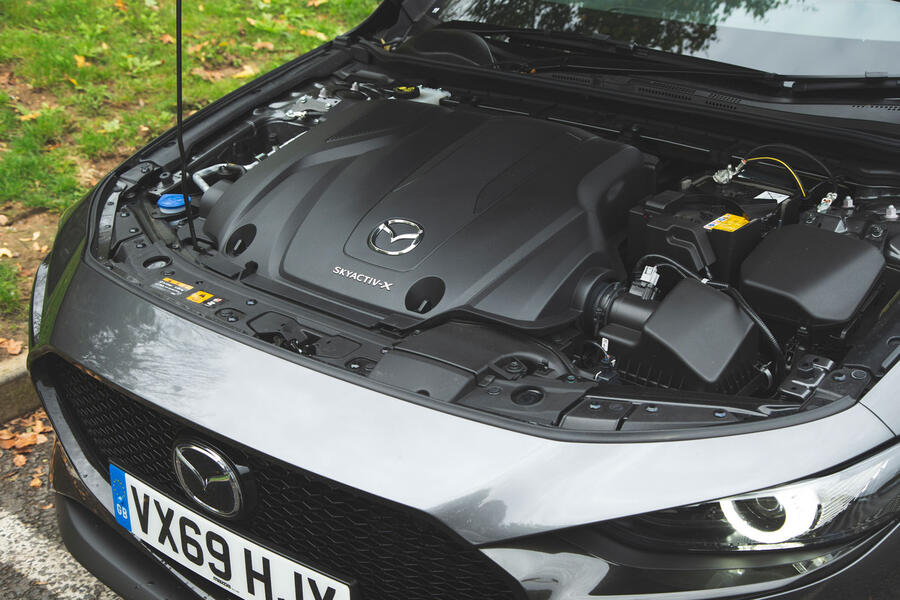
However, there’s more to Mazda’s Ford Focus rival than clever stuff under the bonnet. For starters, the svelte looks have already won favour with the vast majority in the Autocar office. The old model was hardly ugly, but at a stroke it’s made to look lumpen and clumsy by the curvy, clean and minimalist lines of the new model. The proportions, too, mark it out from rivals: that strikingly low bonnet, the low roof and steep rake of the rear window, and the chunky C-pillar give it a distinctive identity, as do the neat front and rear light clusters.
It all means that, in my view, this is the prettiest car in its class, and despite my disappointment that we weren’t getting a Soul Red one, I’m happy with the combination of Machine Grey, black wheels and, especially, the burgundy leather. Ah yes, that interior: another reason to go for the Mazda over the more obvious class choices.
The first thing that strikes you on entering is the perception of quality brought about by everything you touch and interact with. Door cards and armrests are plushly padded, switchgear feels expensively hewn and damped and the material mix is far more Mercedes than Mazda. It’s really impressed everyone who’s been on board so far.
And unlike our now departed long-term A-Class, which I personally felt was more about superficial chintz than actual substance inside, the ergonomic execution seems near-perfect. Niggles will no doubt emerge as the months tick by, but a thousand miles in and I’m struggling to find fault.
There are physical buttons for the things you use regularly, such as the climate controls, simple music functions and some driver assist features. But even the functions that are buried in the infotainment are easily accessible, as Mazda (along with BMW) is one of the last to keep the super-intuitive rotary click wheel, which combines with simple, clear menus to make every task a doddle. Other manufacturers, take note: your cars are getting more frustrating to operate because of the over-reliance of touchscreen fingerprint magnets and dodgy voice control.
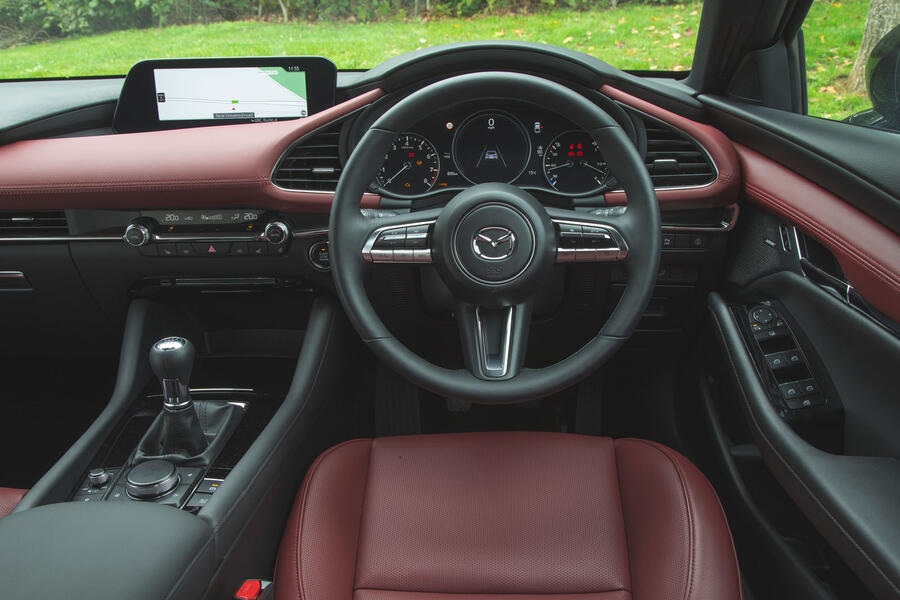
Not that the Mazda is lacking on the kit front. Our GT Sport trim is one rung below top spec, and it’s crammed with features like heated leather seats (electric on the driver’s side), a heated steering wheel, a 12-speaker Bose sound system, a head-up display – the list goes on. You don’t need to splash out on our spec, though: even base models get LED headlights, traffic-sign recognition and – amazingly – radar cruise control. The Mazda’s keyless entry is great, too, allowing you to lock the car with a swipe of the door handle – useful, as the key isn’t the most pleasant thing to behold.
Complaints so far? We have to nitpick. The driver’s seat doesn’t quite go low enough for a truly sporting feel, while I can already see there will be some complaints from those in the back due to the shortage of head room. If that’s all we can whinge about, then it’s a great start. Time well spent with the car will dictate whether the gushing reports continue to flow.
Second Opinion
I couldn’t wait to try out the new Mazda 3, having been blown away by its fantastic design. Turns out the interior is the real star: it looks superb, feels lovely and works seamlessly. Must admit, I felt a tad let down by the Skyactiv-X engine, because I expected diesel-like torque, but it did prove frugal.
Kris Culmer
Mazda 3 2.0 Skyactiv-X GT Sport specification
Prices: List price new £26,675 List price now £27,440 Price as tested £27,545 Dealer value now £22,178 Private value now £19,714 Trade value now £18,500 (part exchange)
Options:Machine Grey metallic paint £670, burgundy leather trim £200
Fuel consumption and range: Claimed economy 48.7mpg Fuel tank 51 litres Test average 43.1mpg Test best 43.8mpg Test worst 41.9mpg Real-world range 482 miles
Tech highlights: 0-62mph 8.2sec Top speed 134mph Engine 4cyl, 1998cc, petrol Max power 178bhp at 6000rpm Max torque 165lb ft at 3000rpm Transmission 6-spd manual Boot capacity 358/1138 litres Wheels 18in, alloy Tyres 215/45 R18 Kerb weight 1411kg
Service and running costs: Contract hire rate £261.67 CO2 131g/km Service costs None Other costs Wheel alignment £18 Fuel costs £908 Running costs inc fuel £908 Cost per mile 11 pence Depreciation £8175 Cost per mile inc dep’n 44 pence Faults none

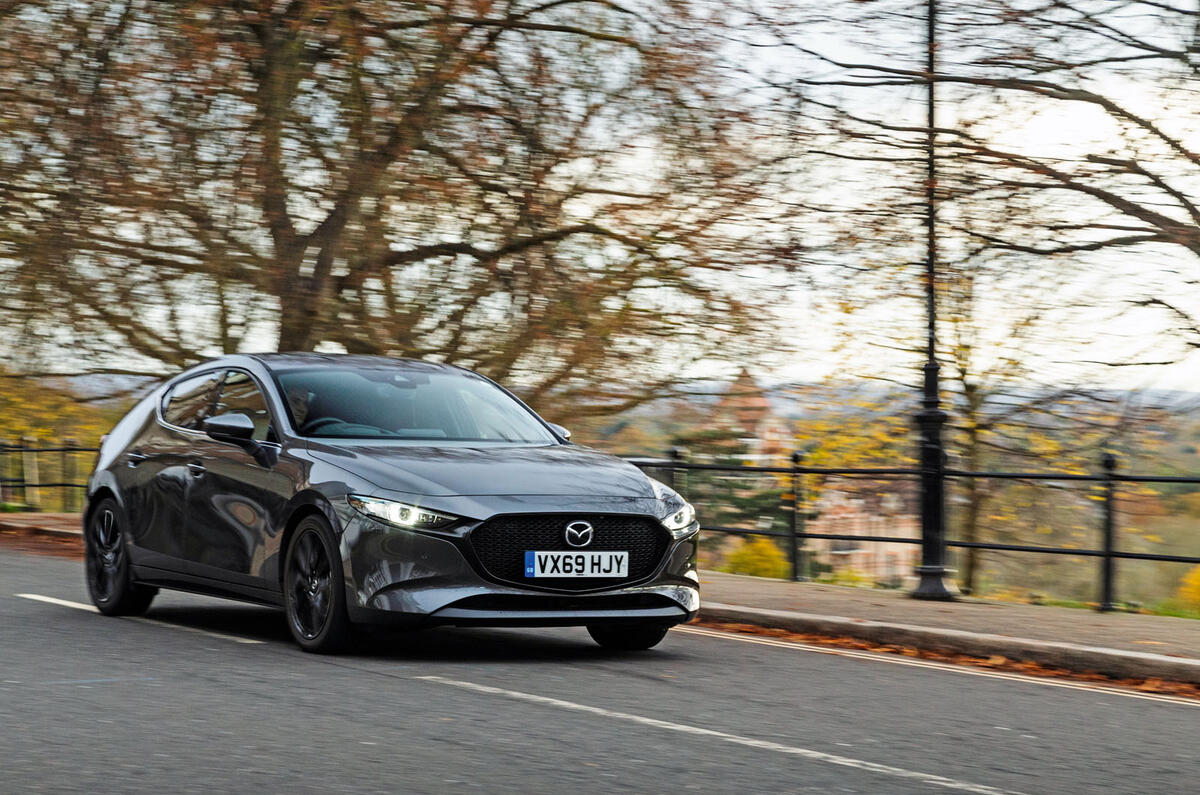
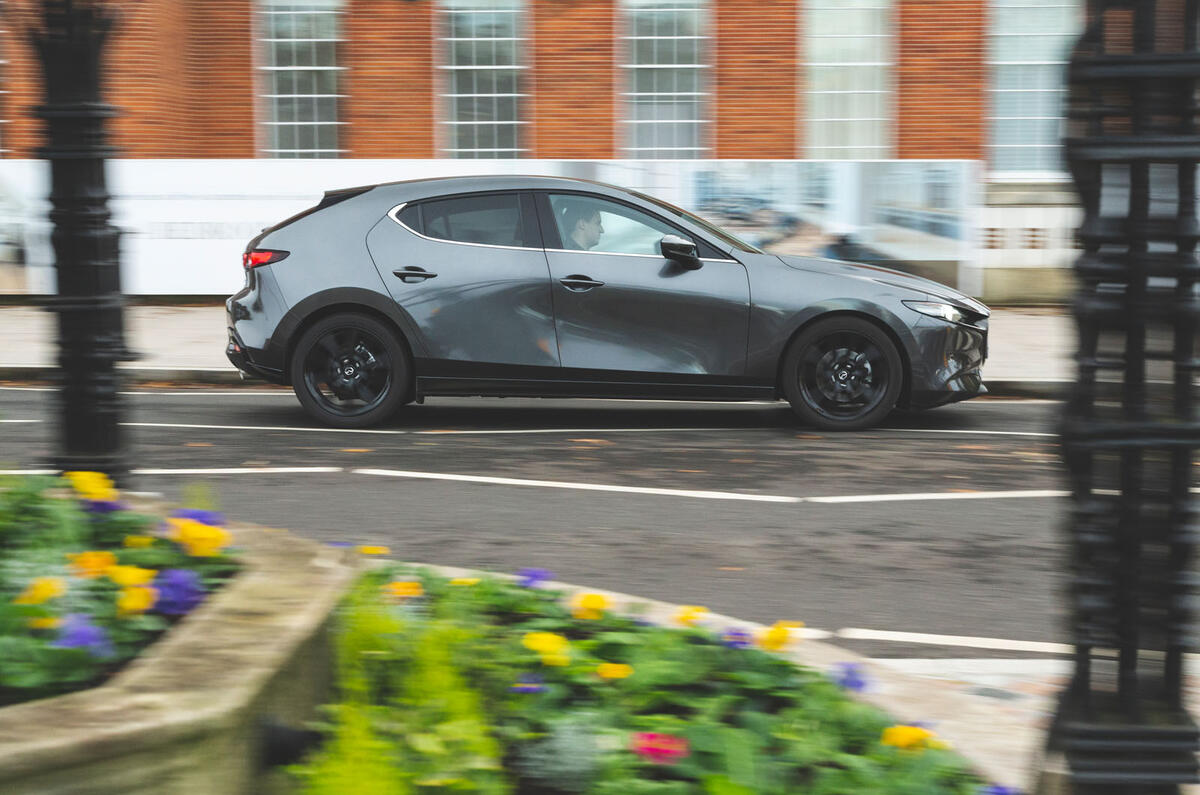
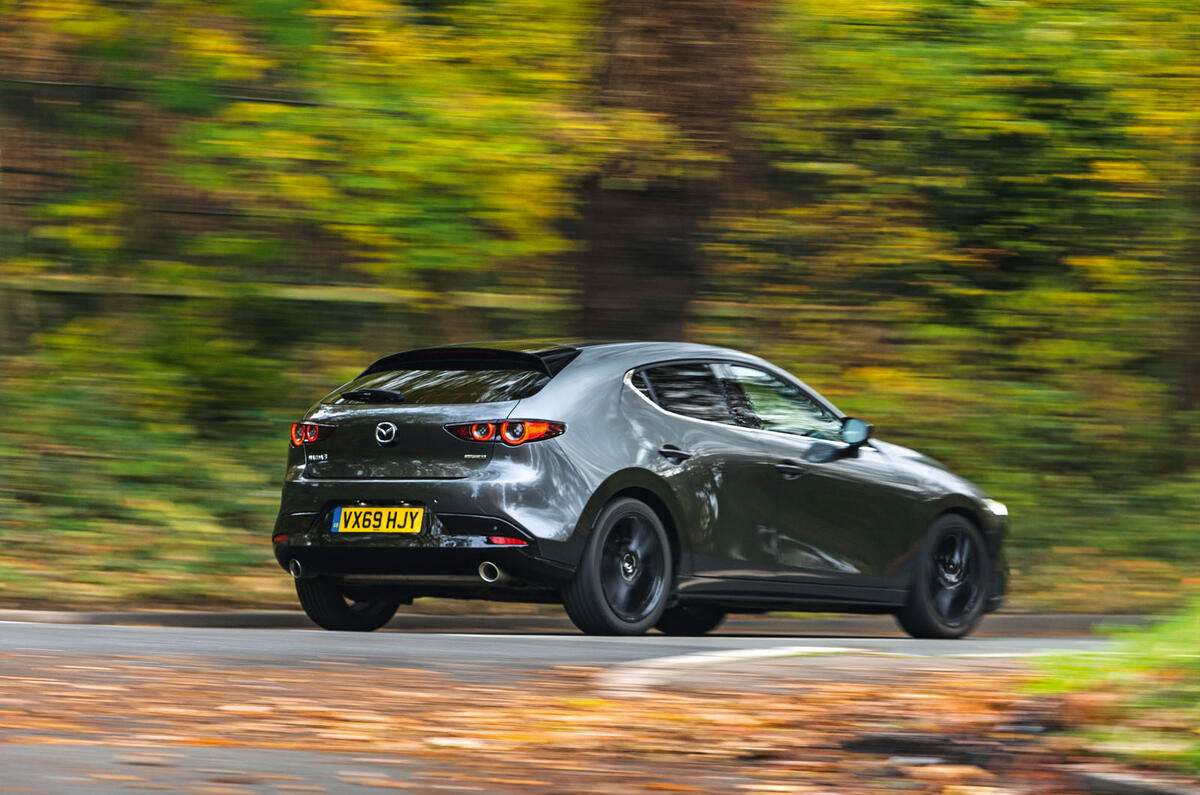
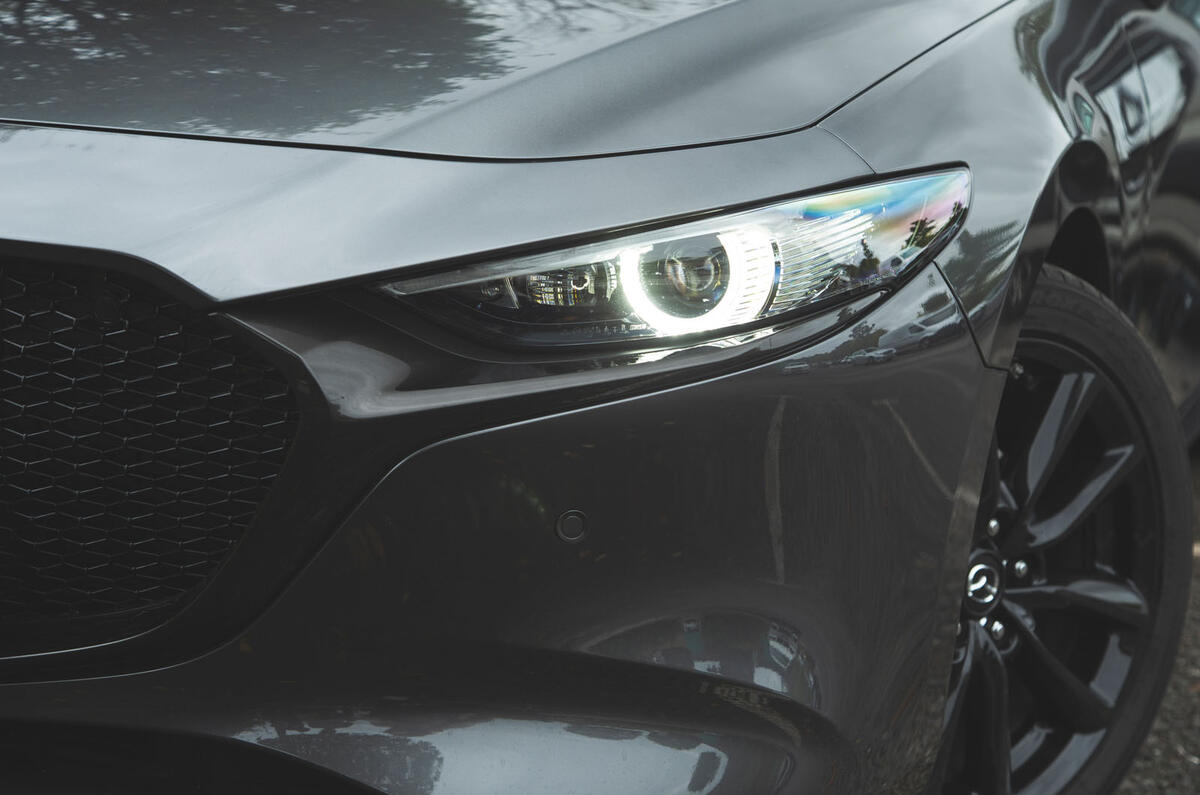

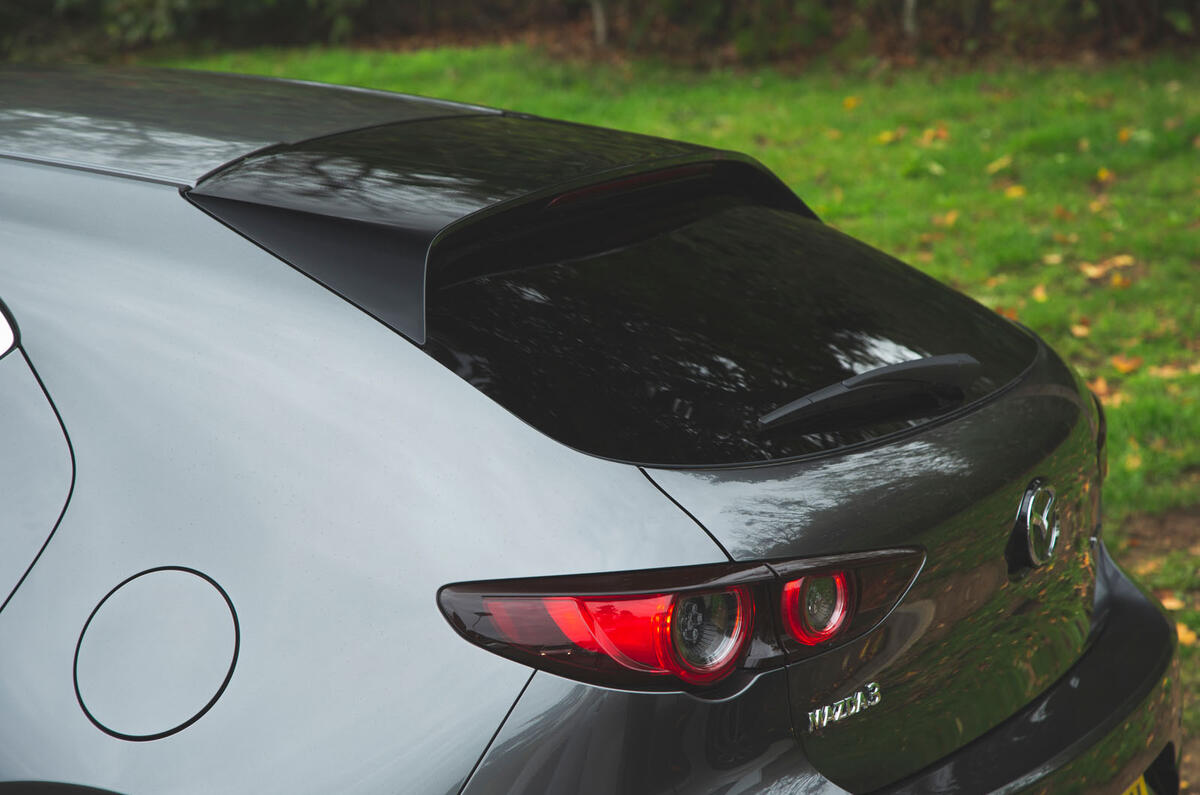
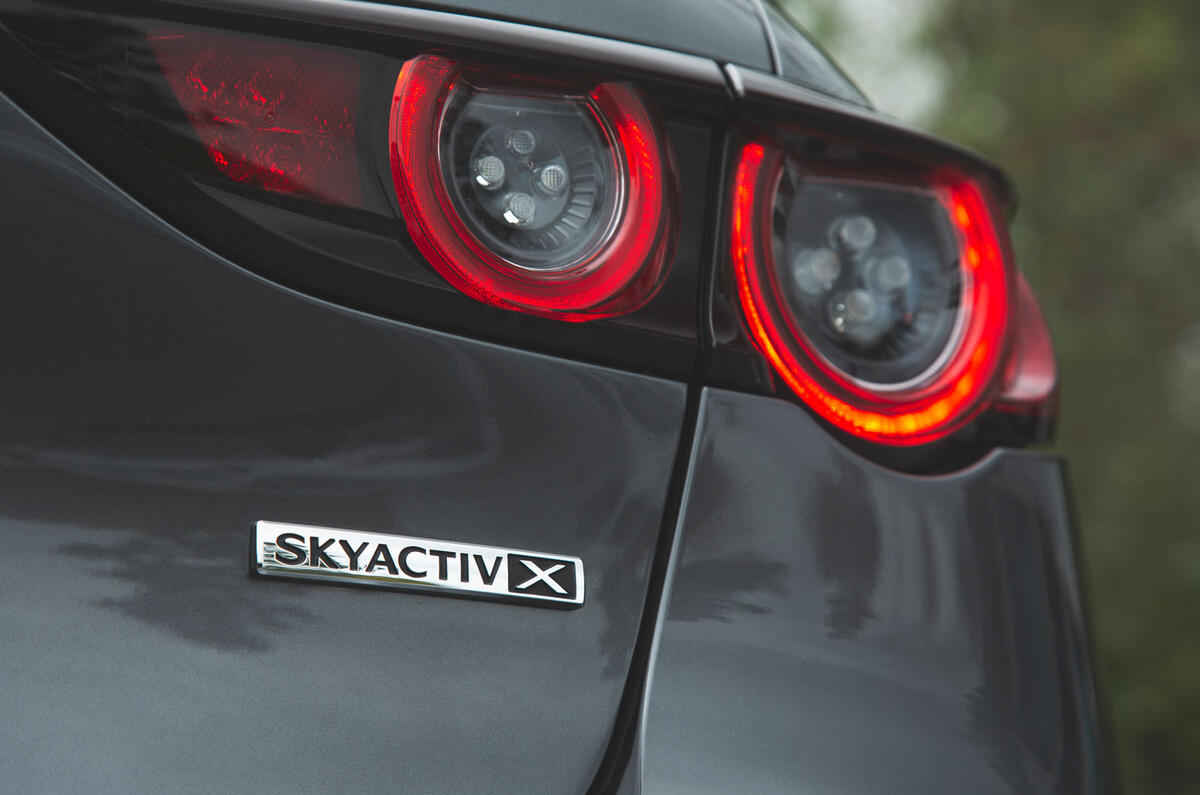
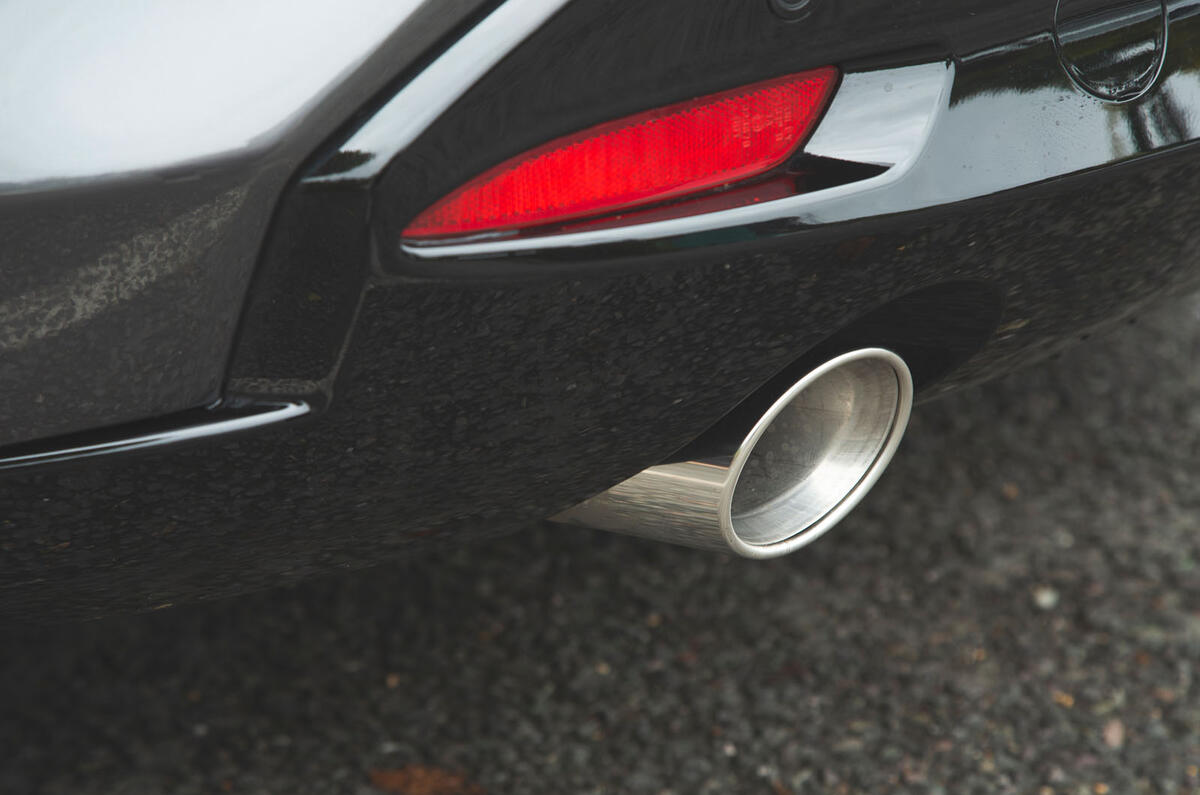

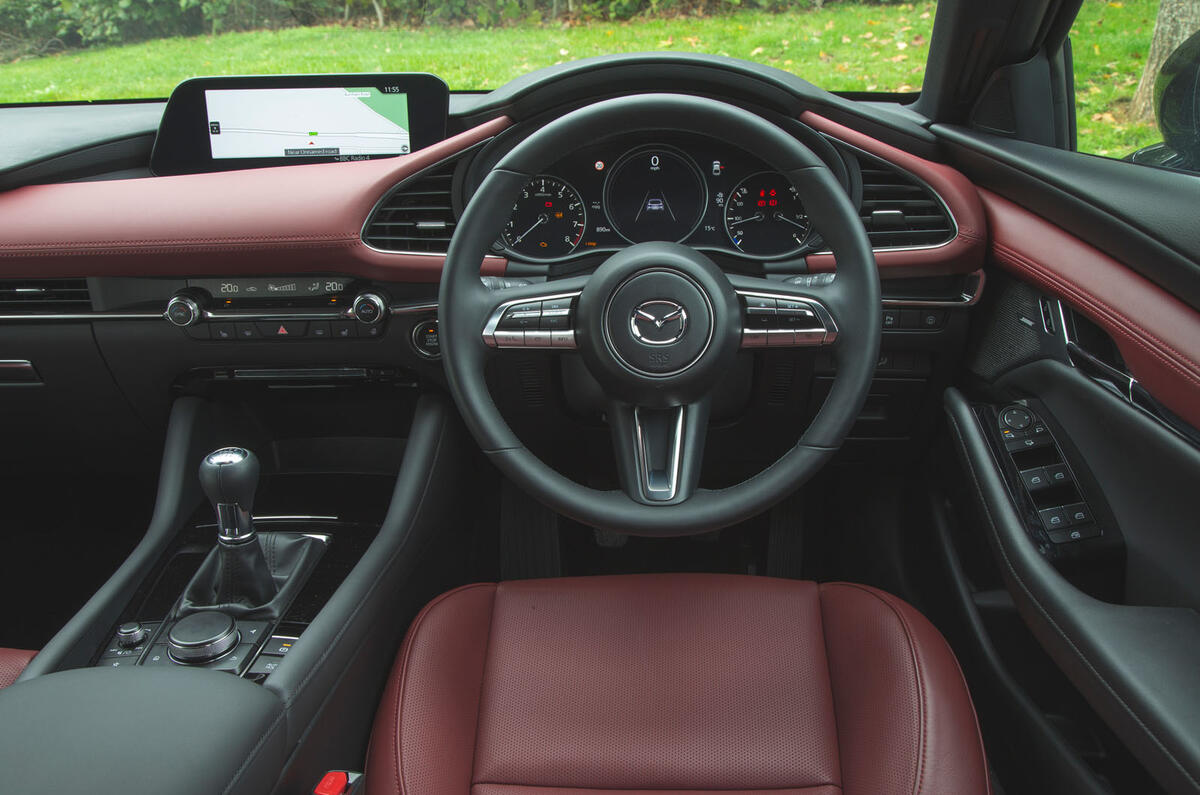
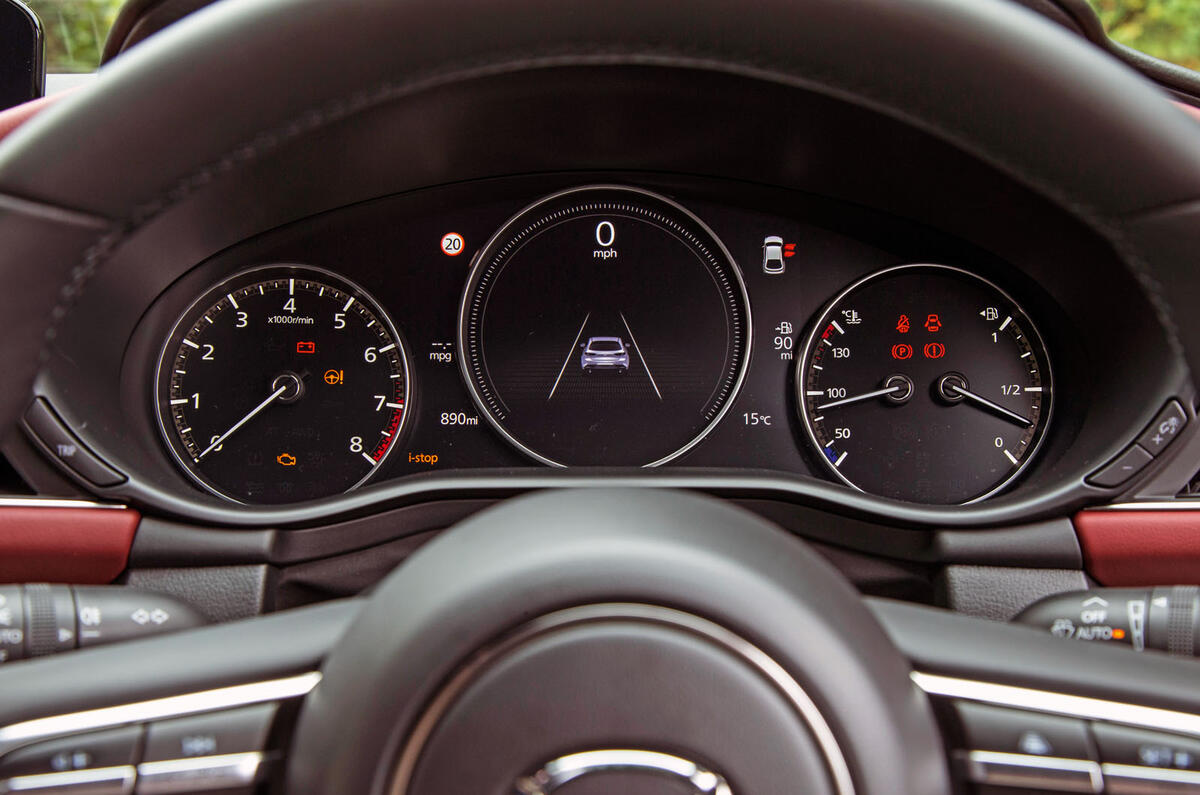
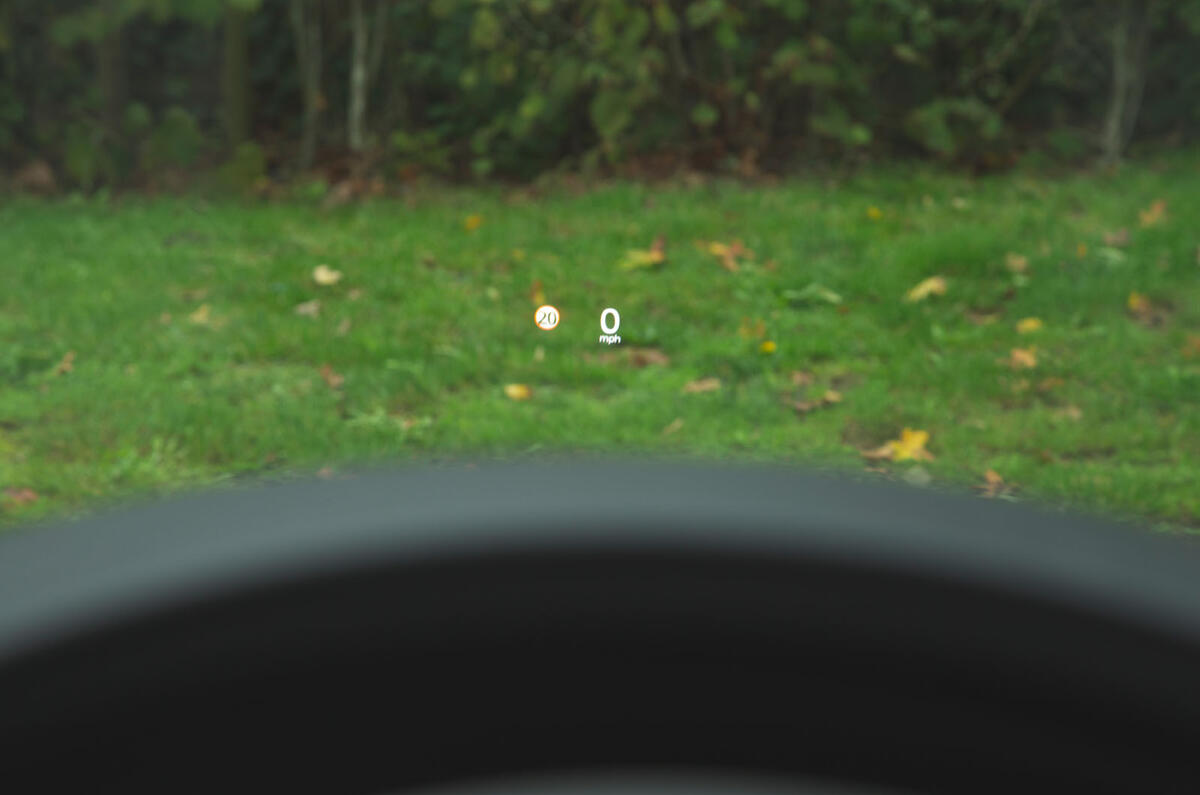
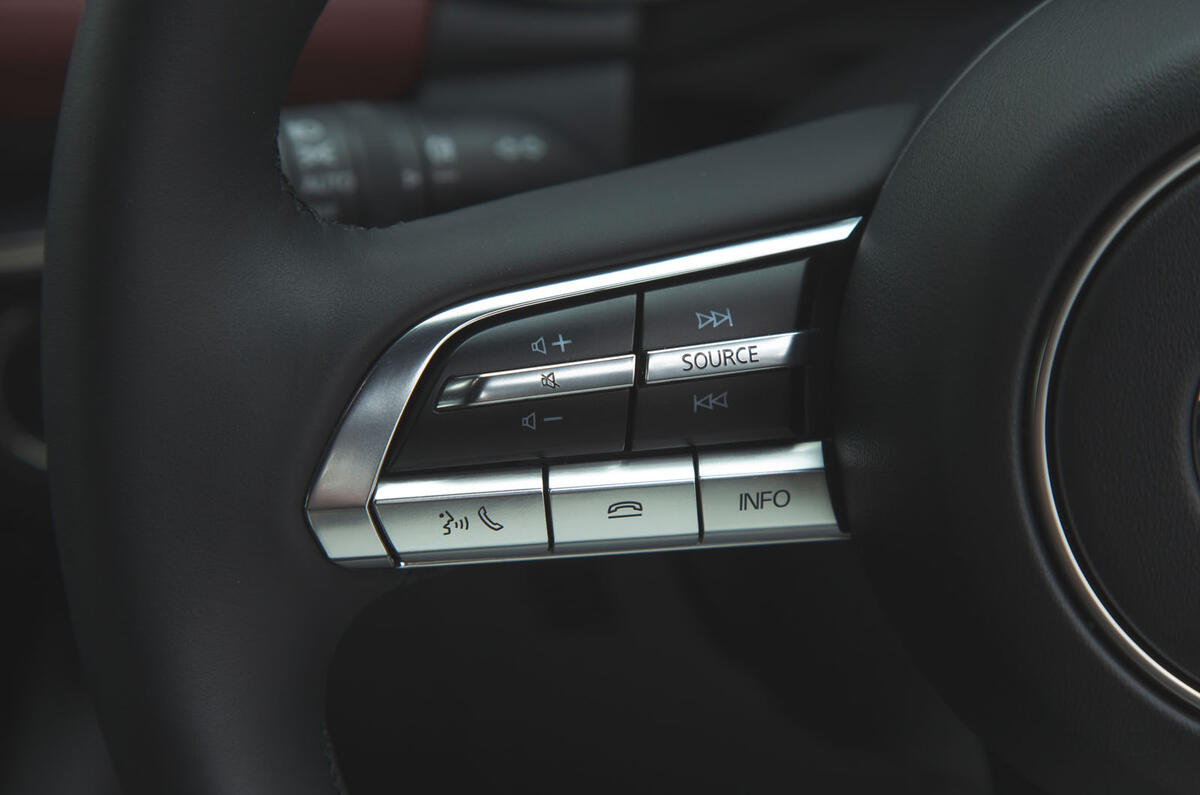
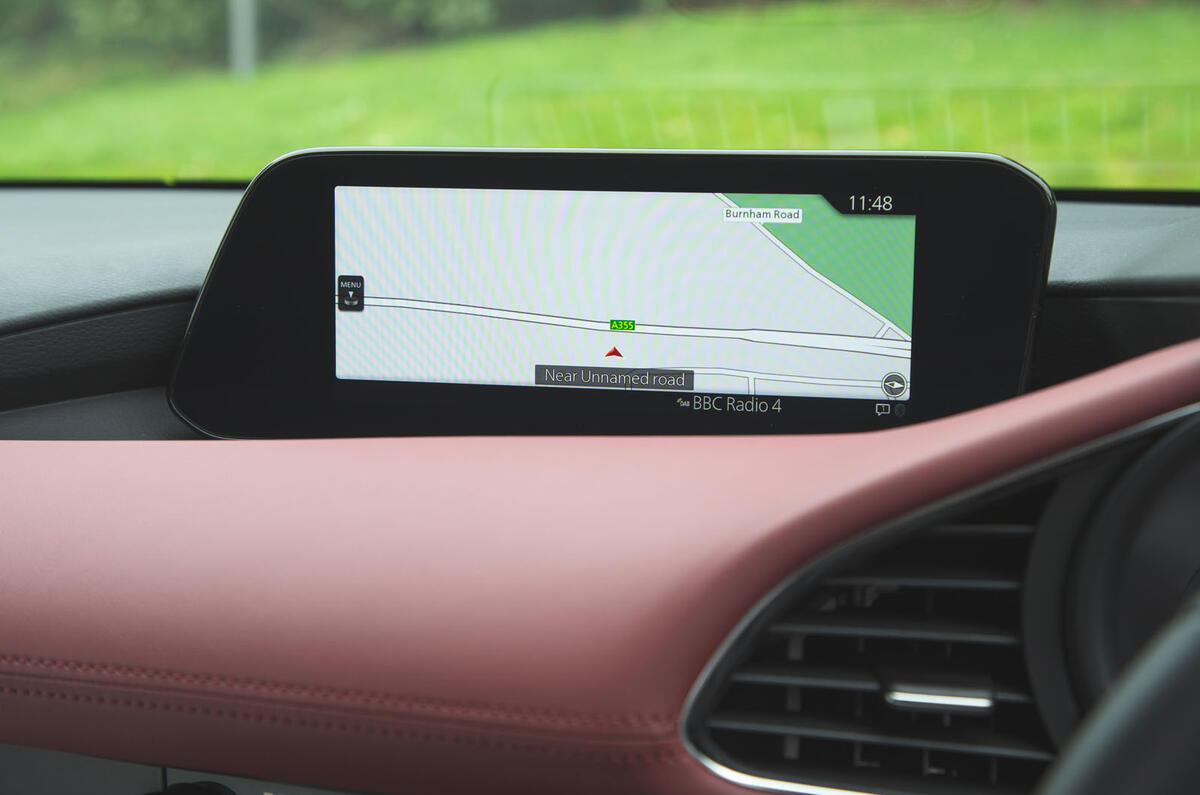
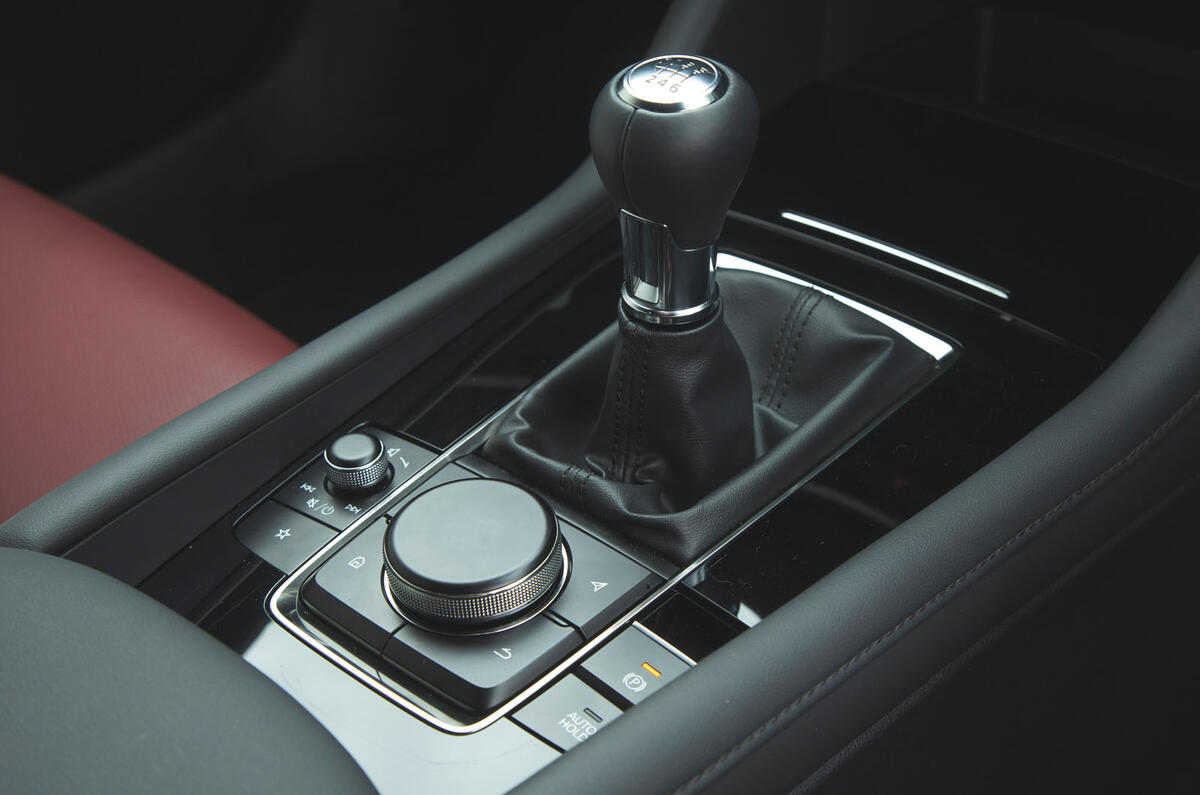
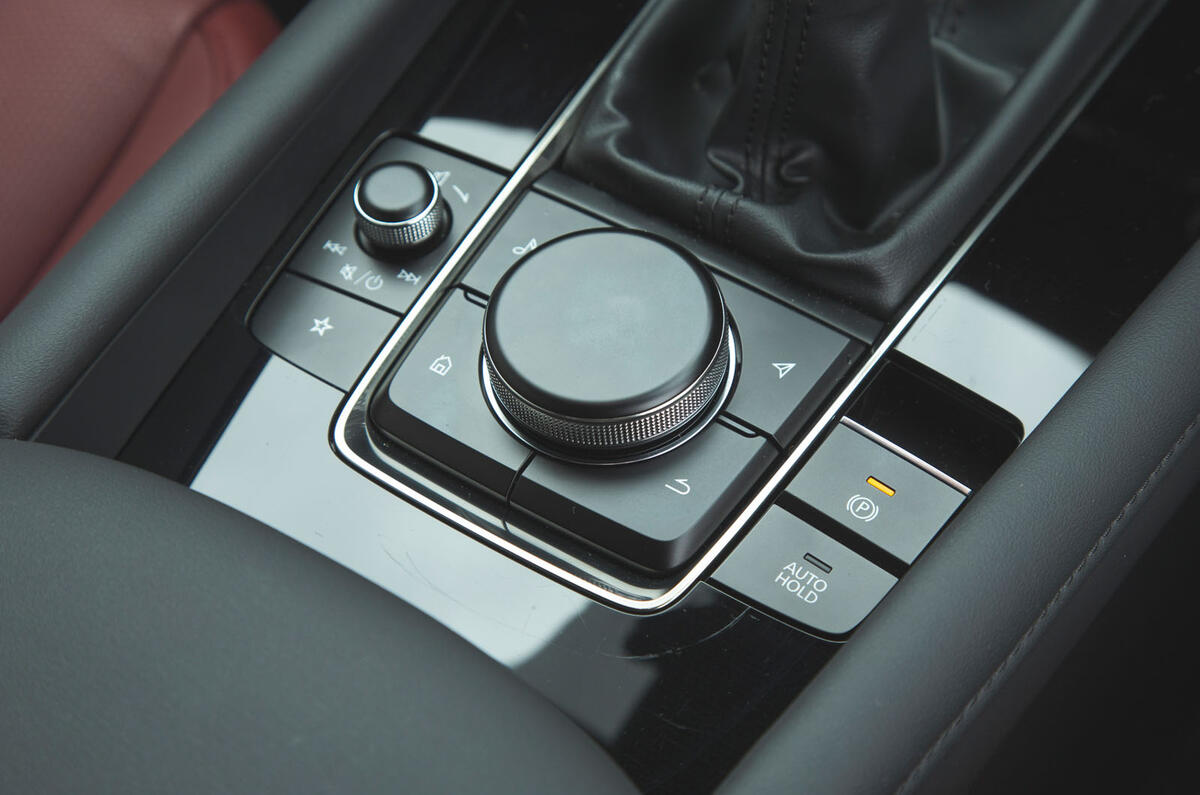
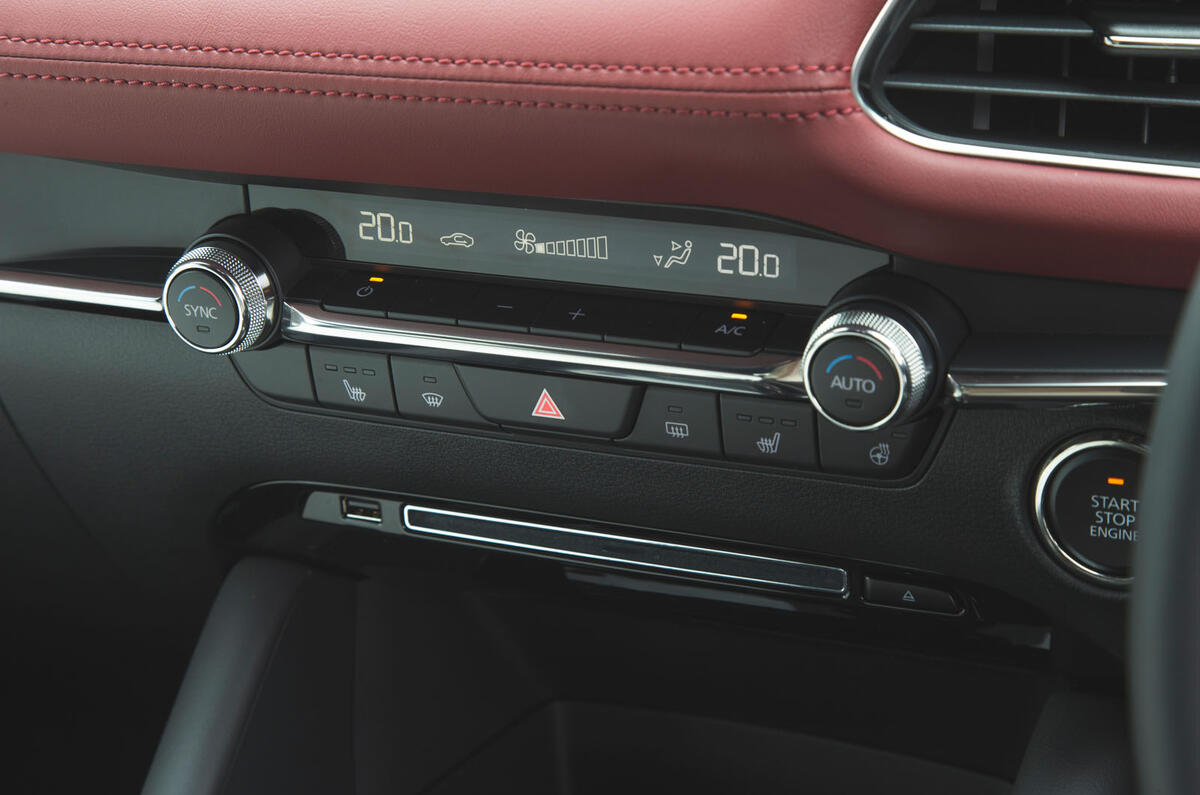
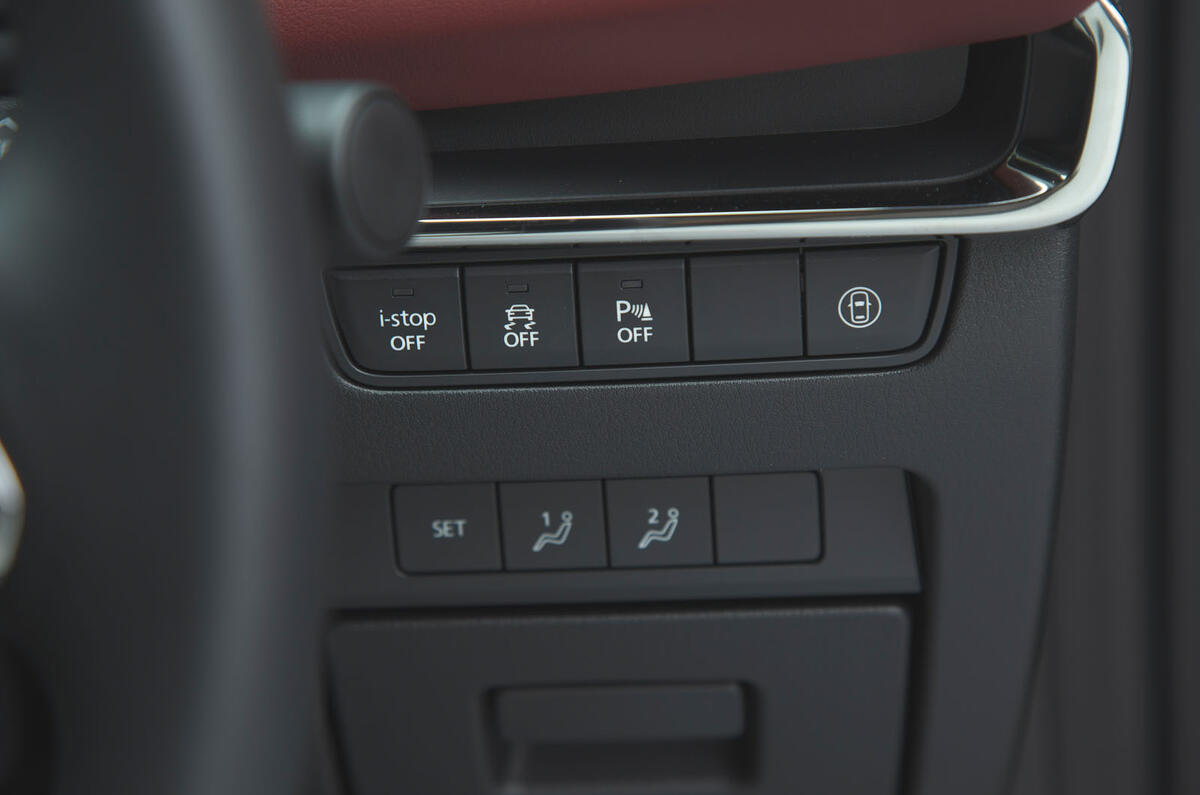
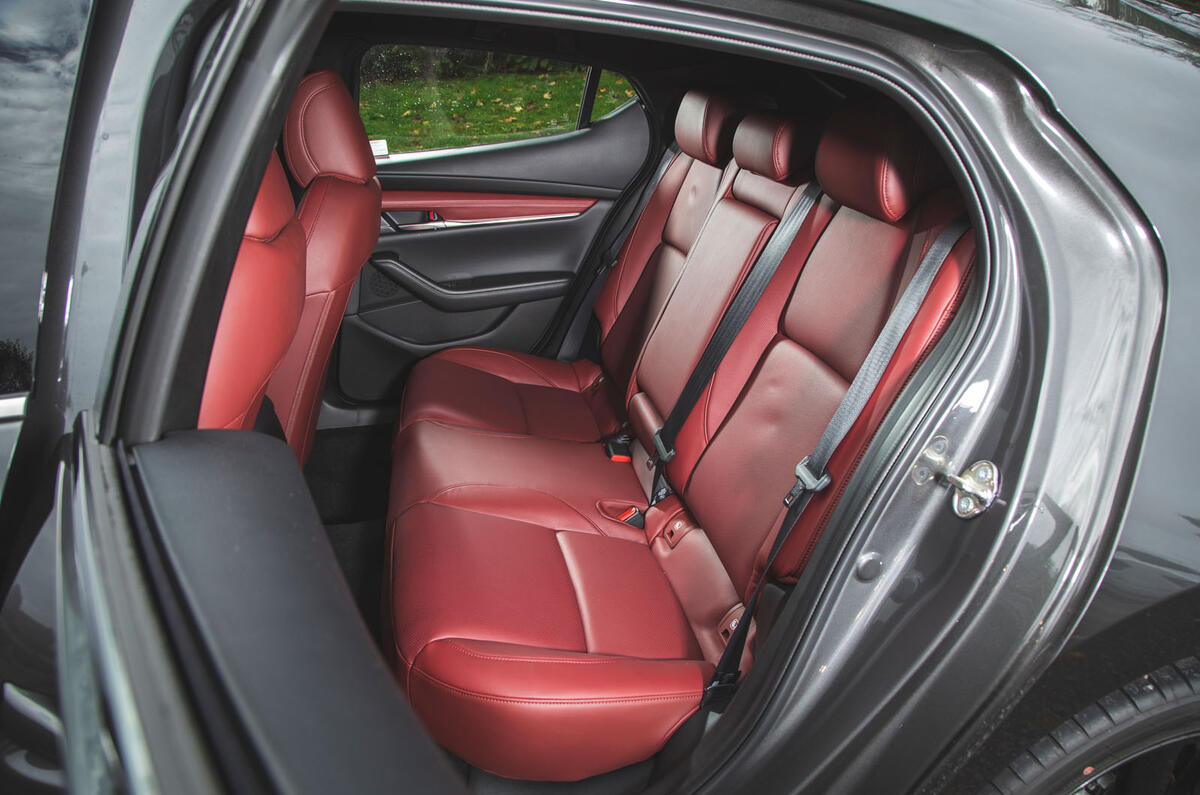
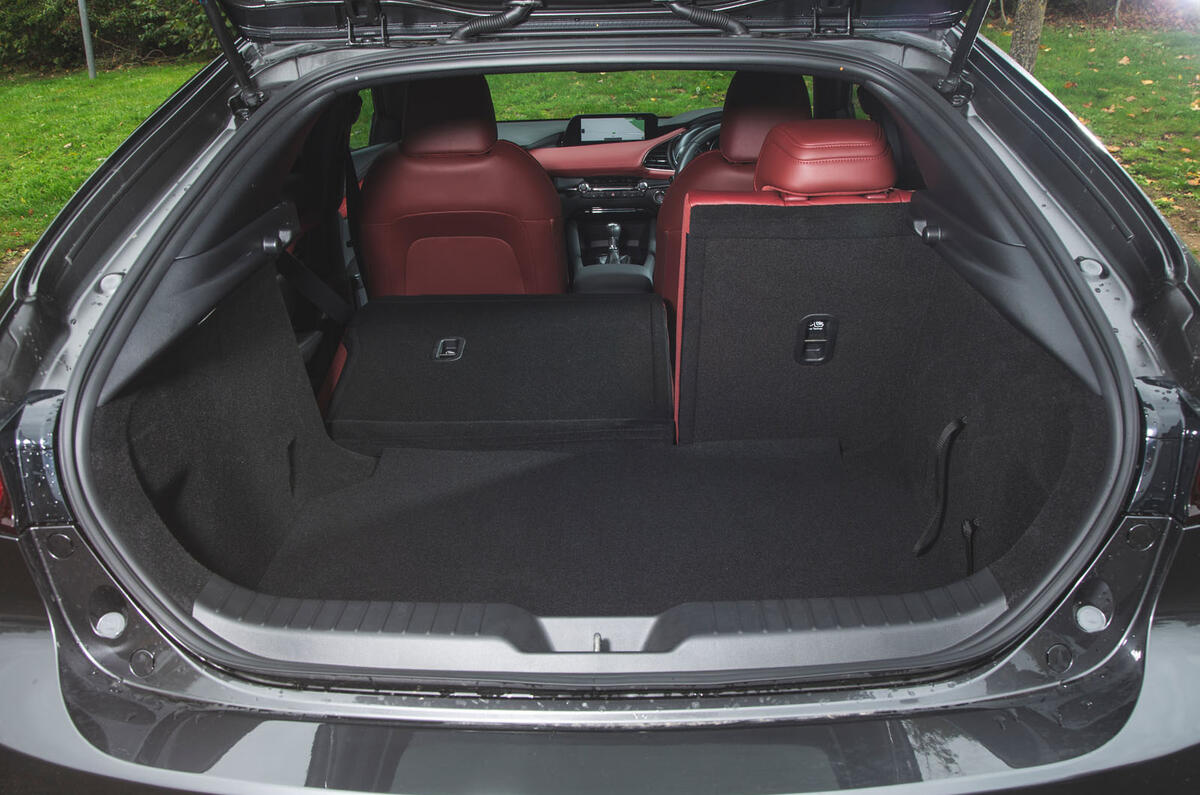
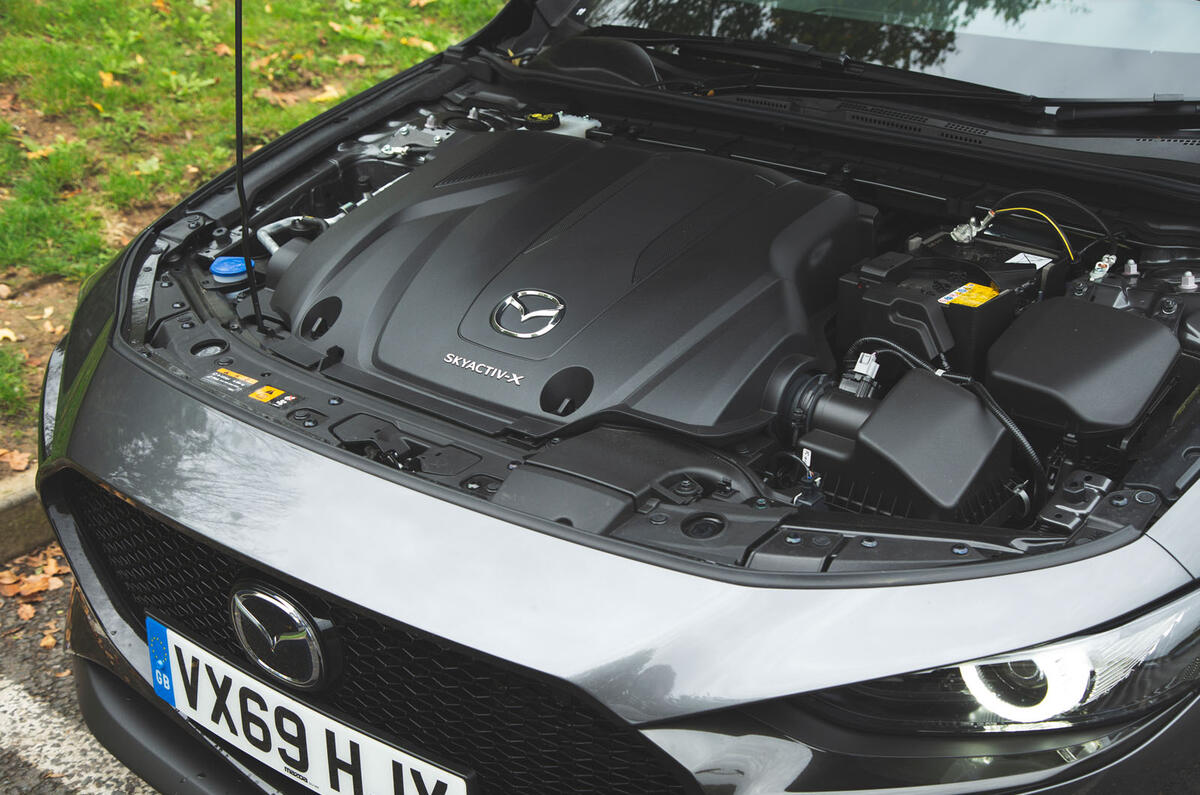
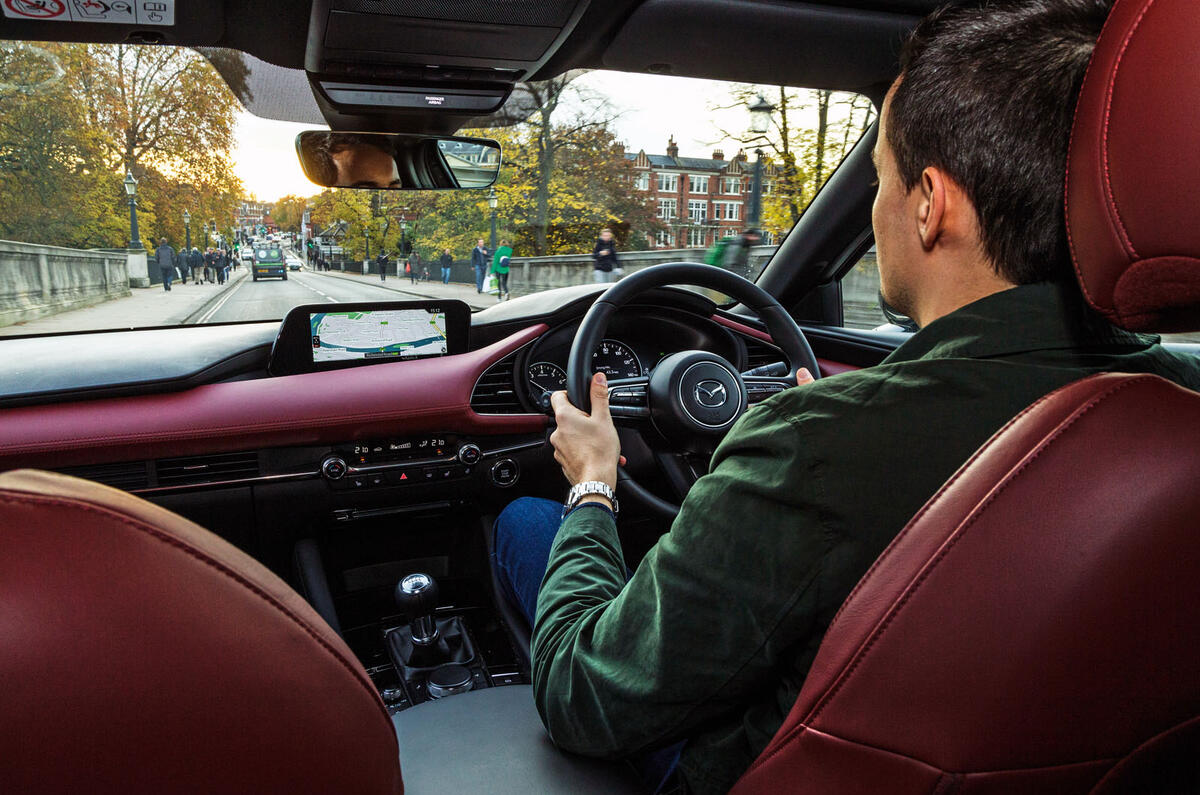
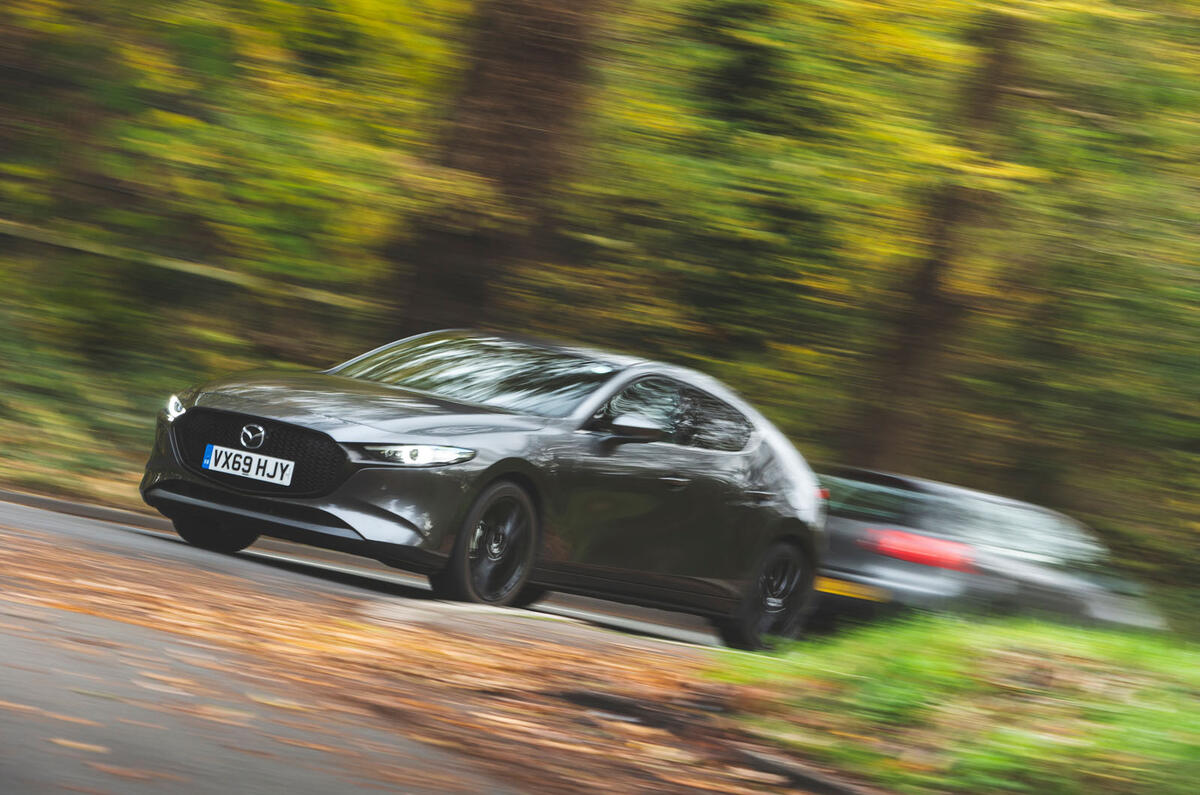
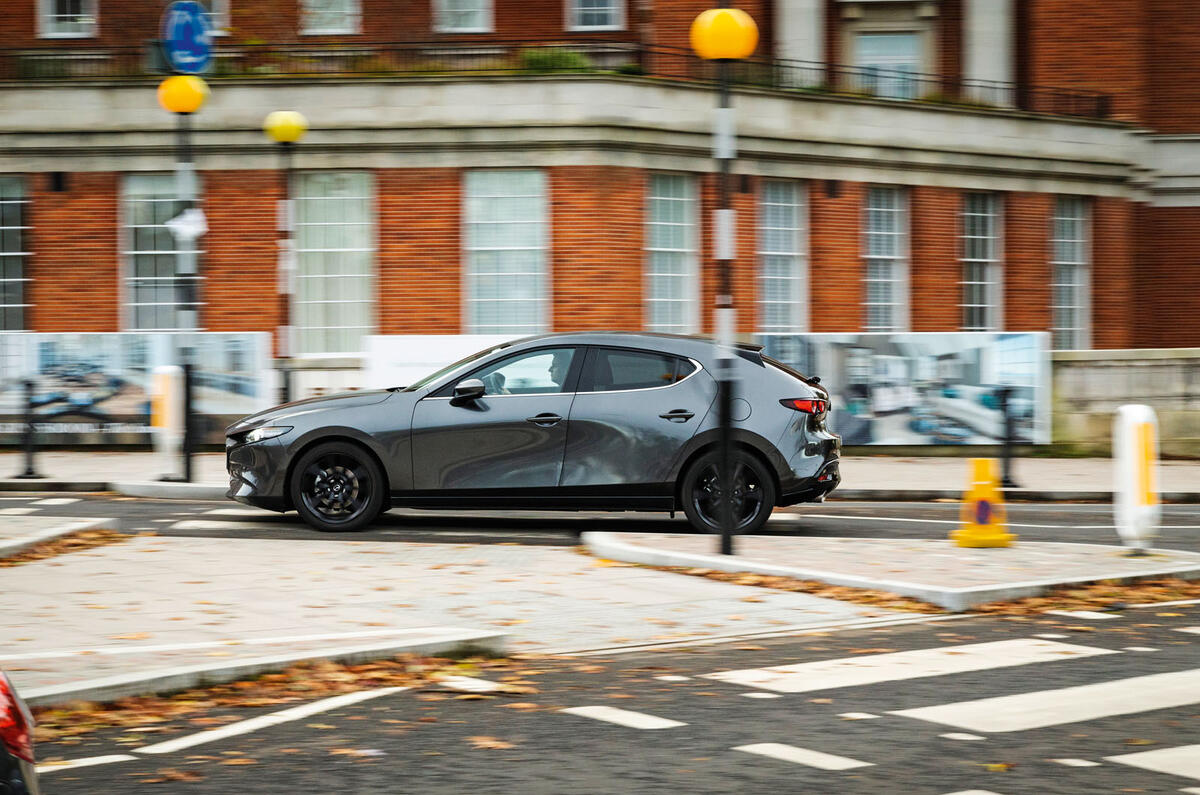
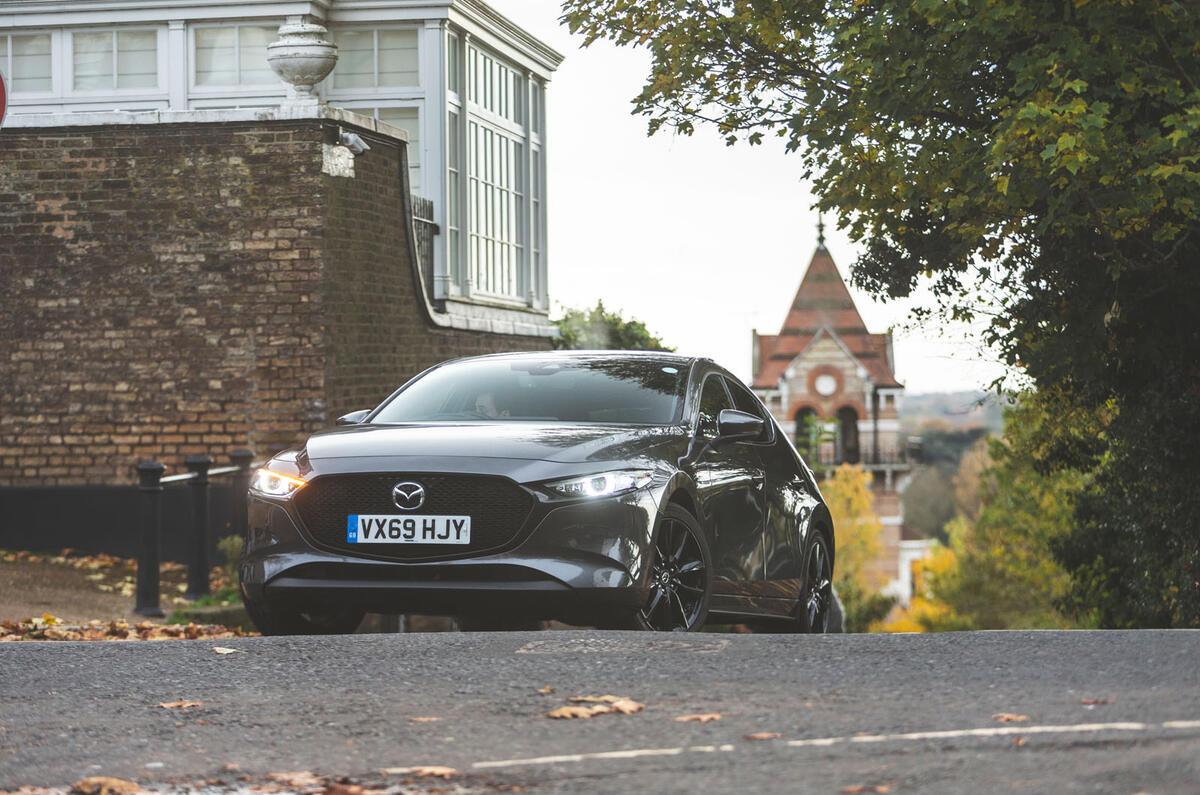
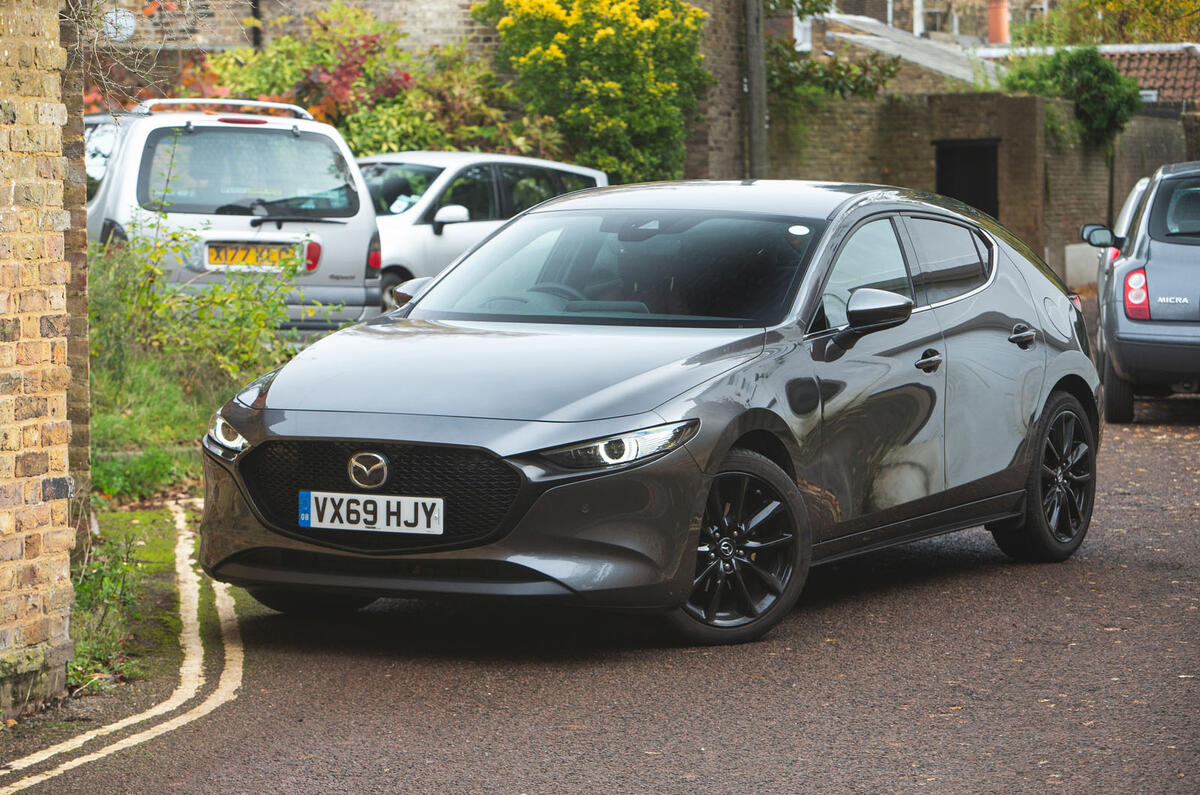
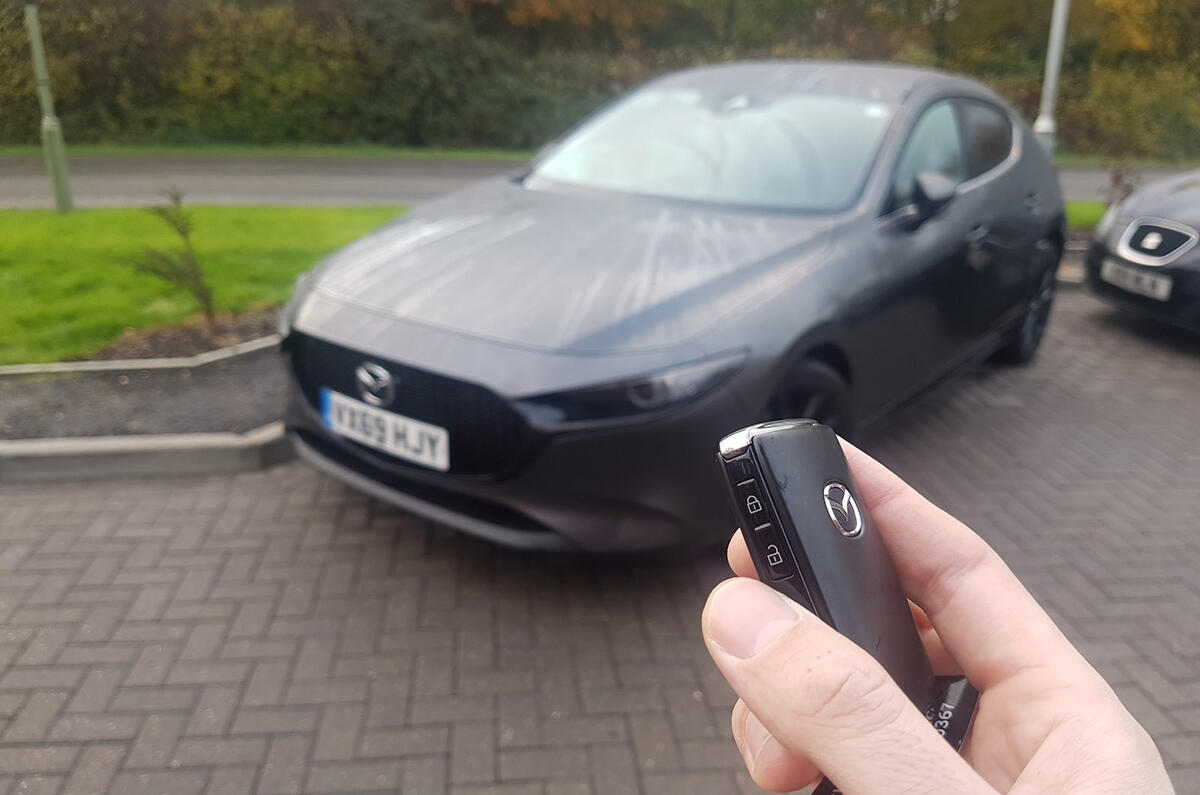
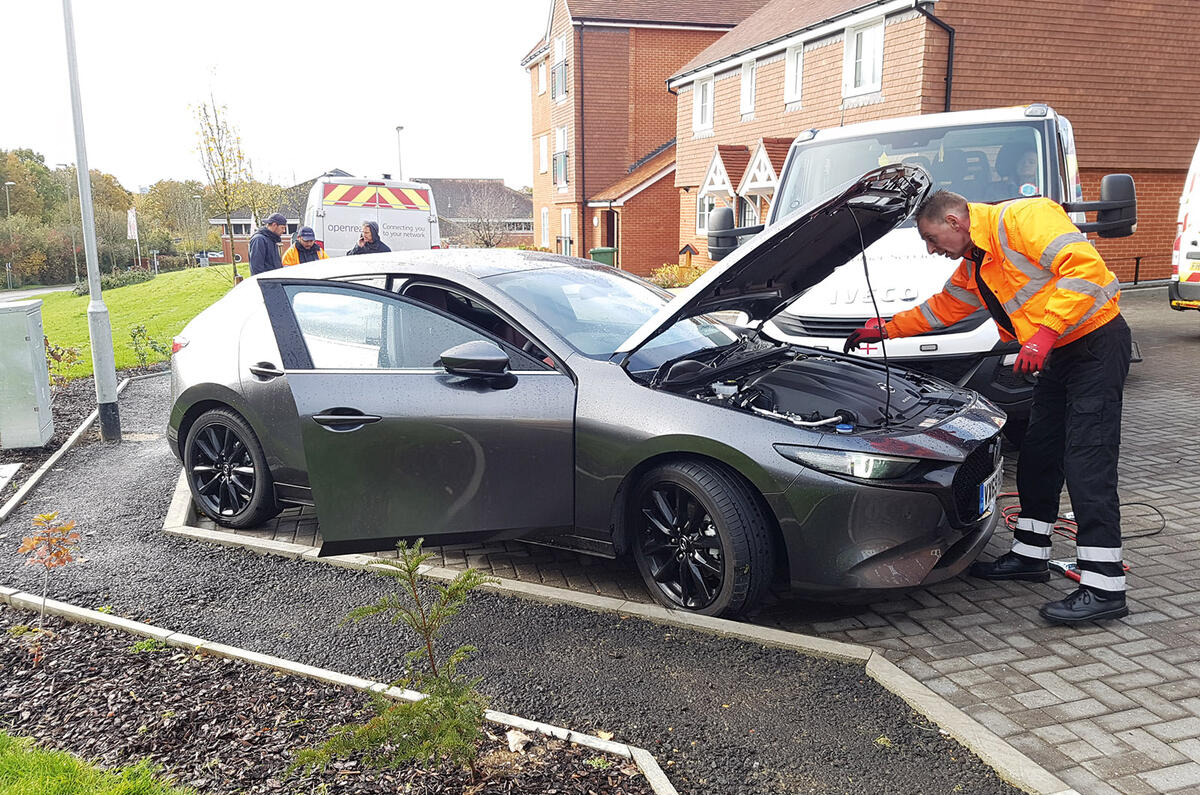
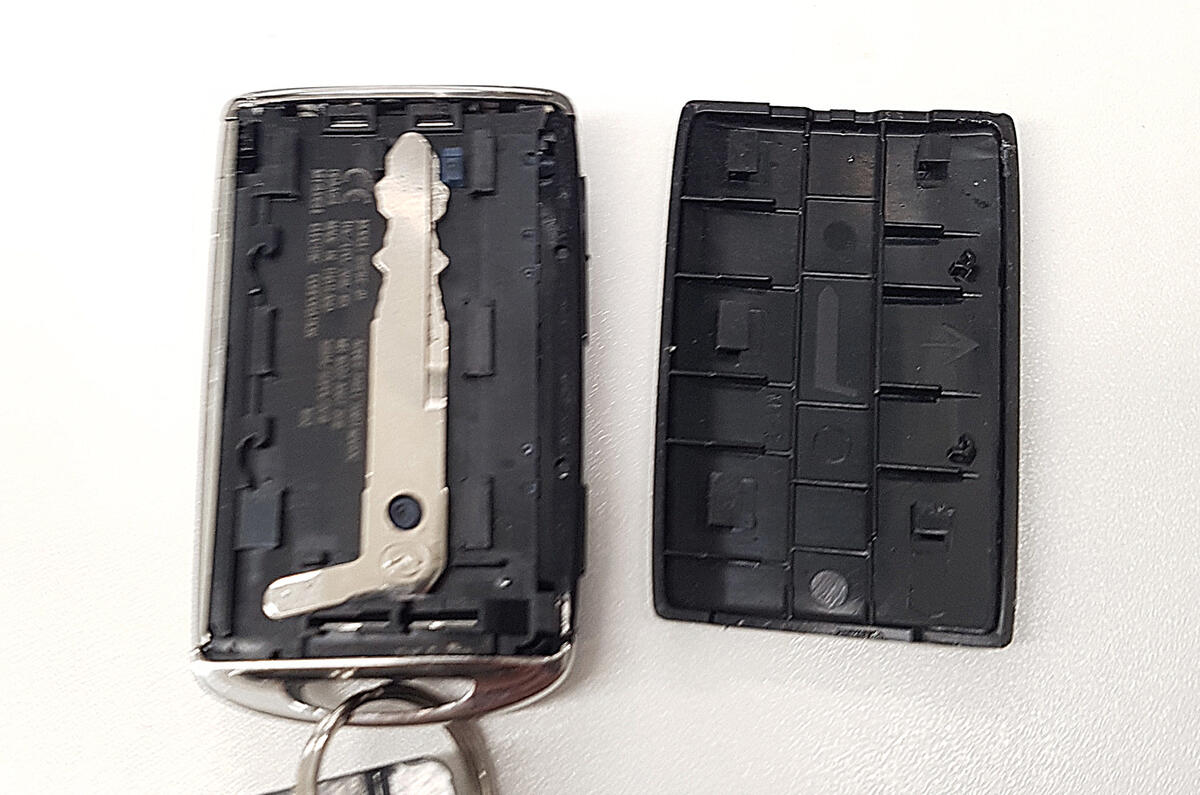
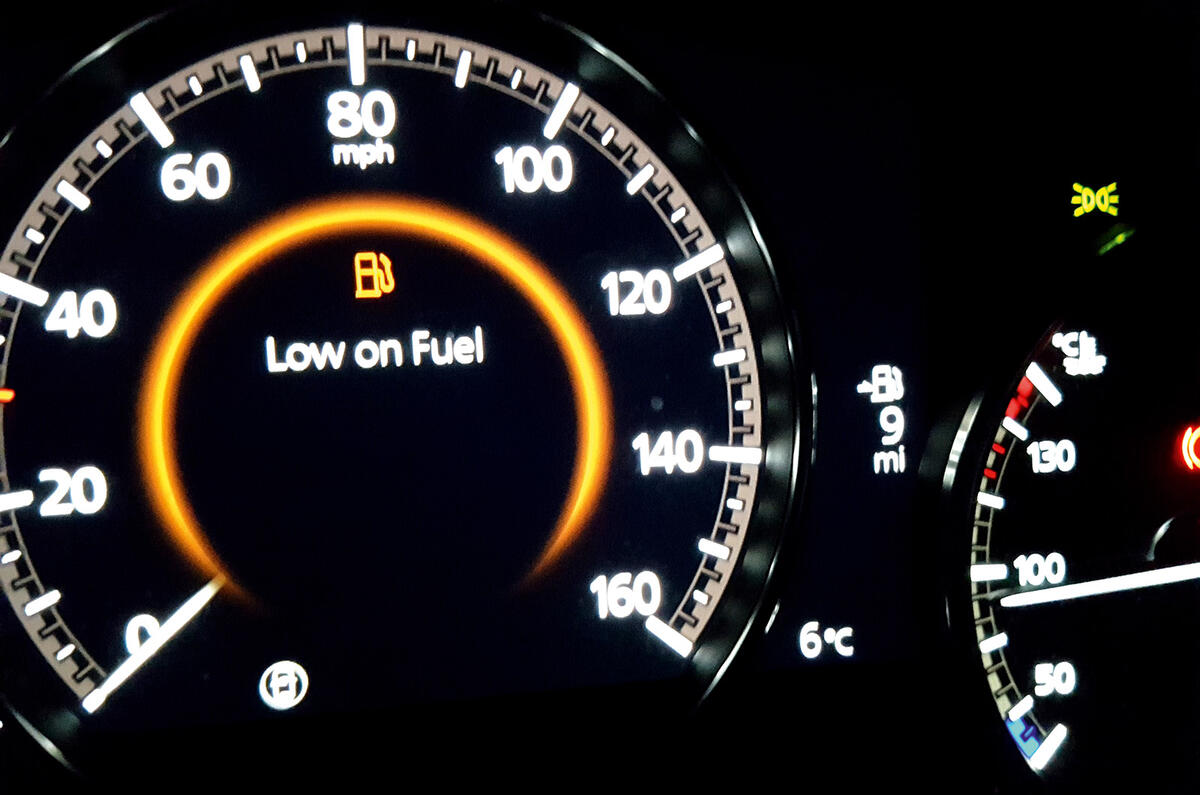
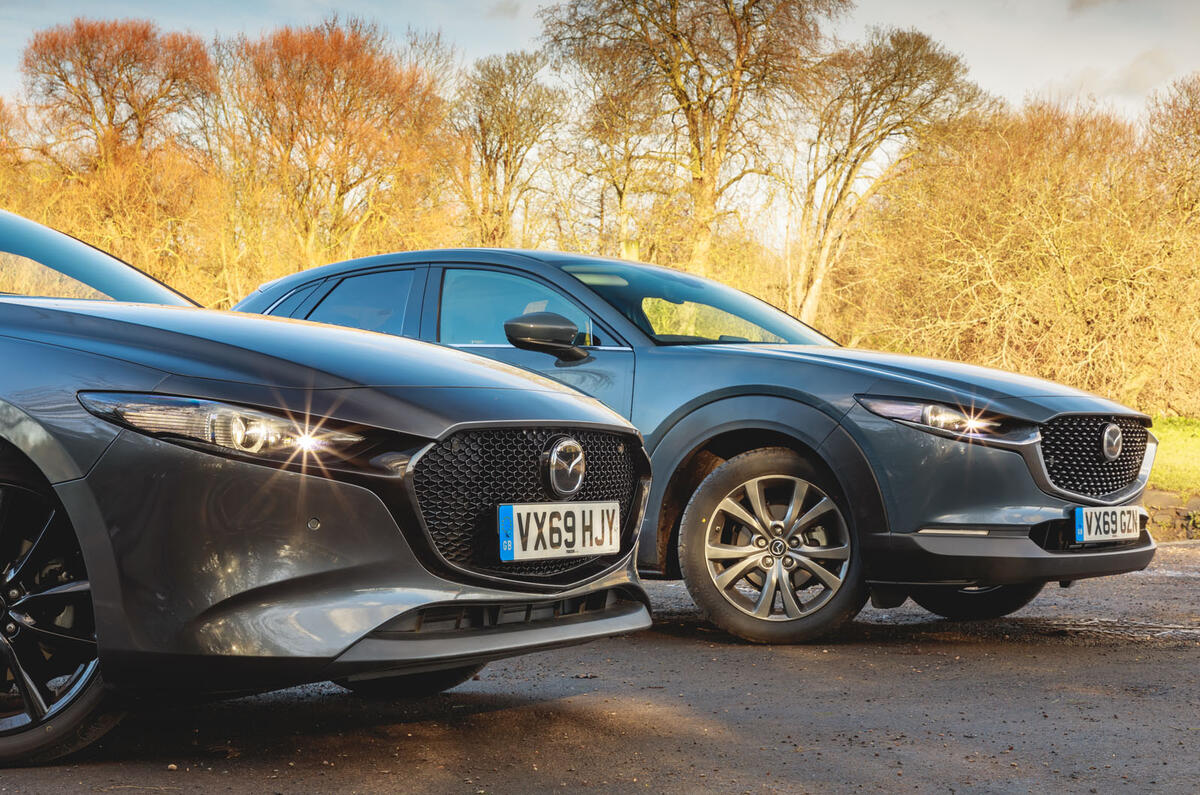
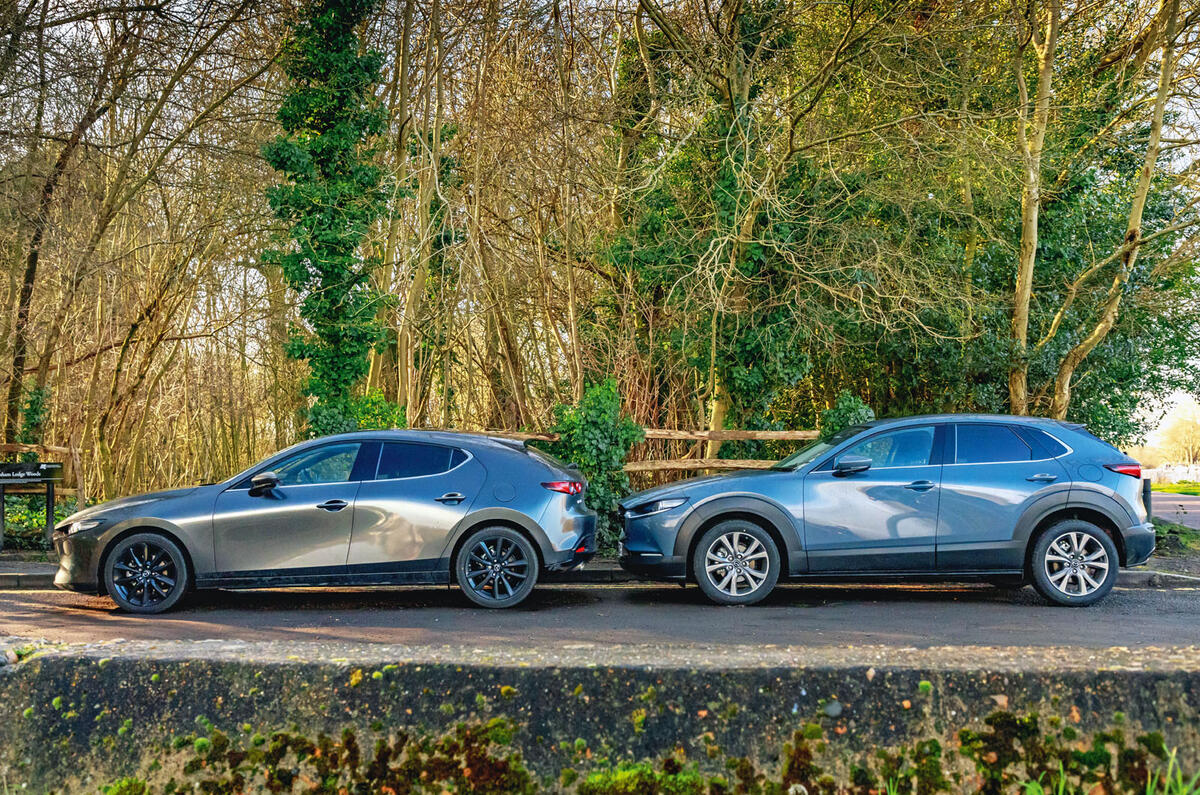
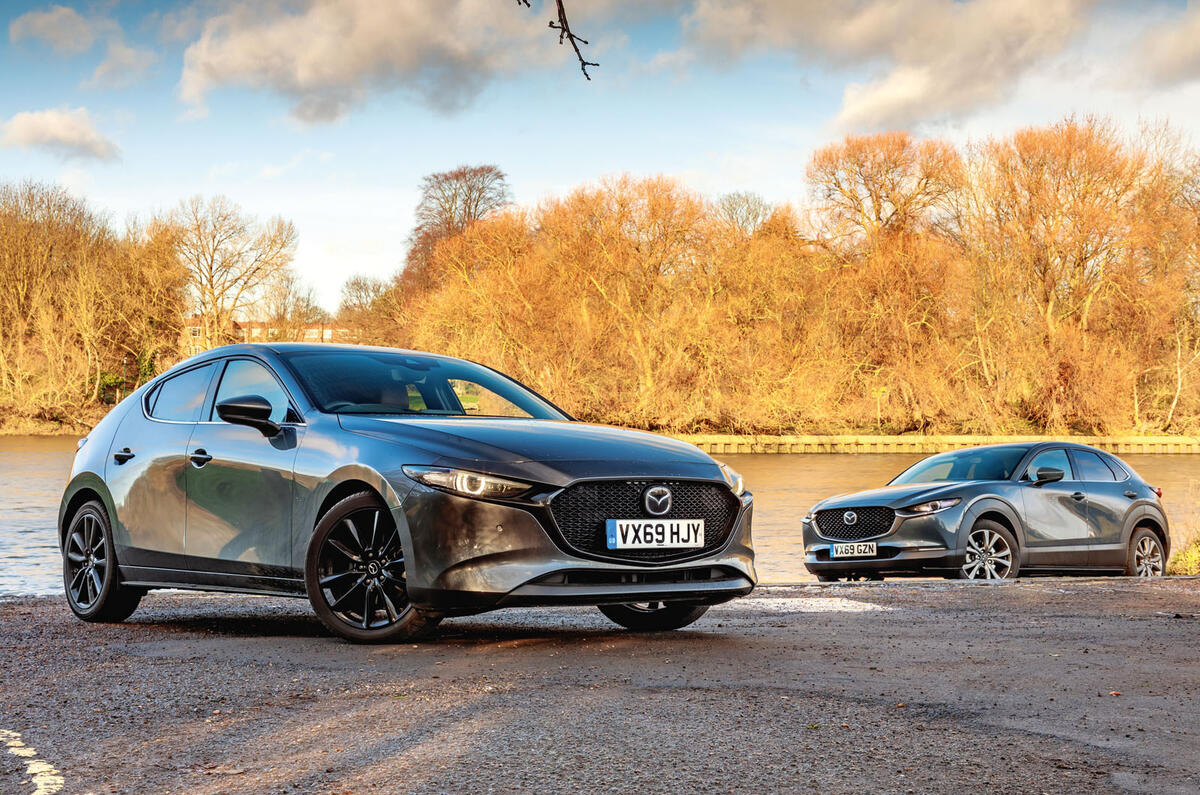
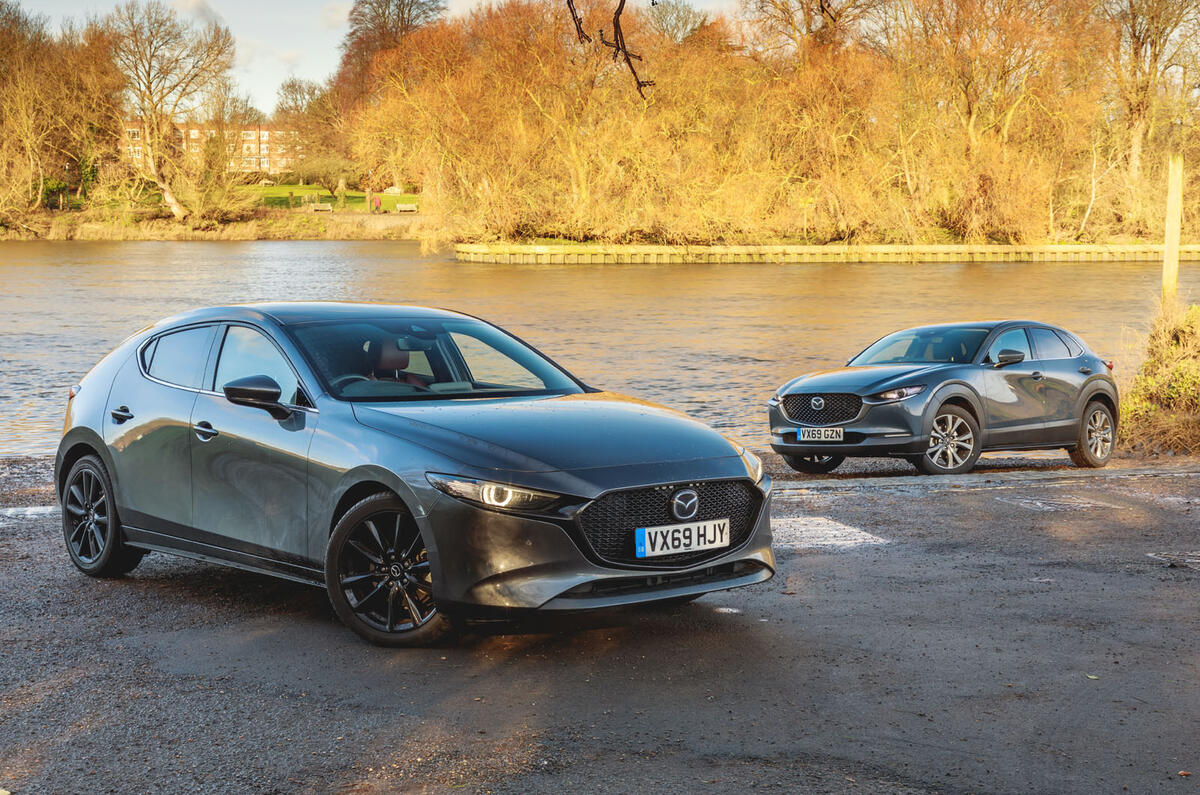

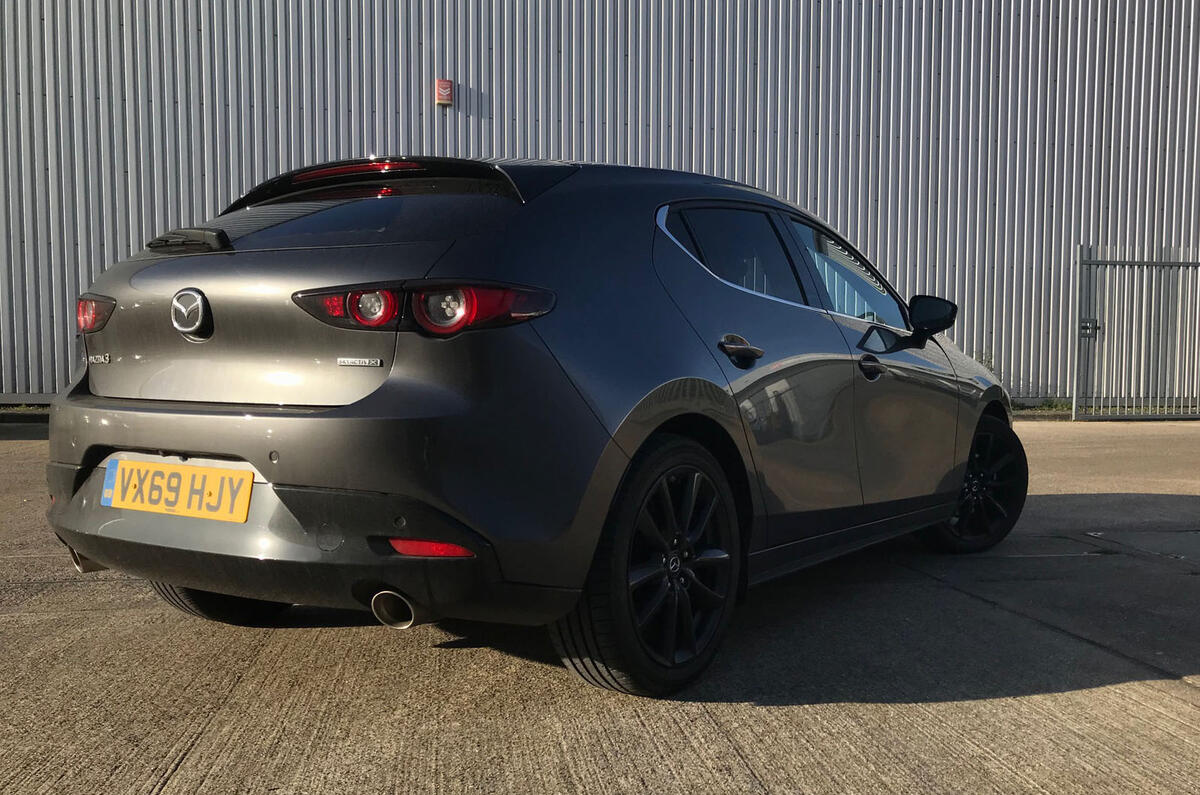
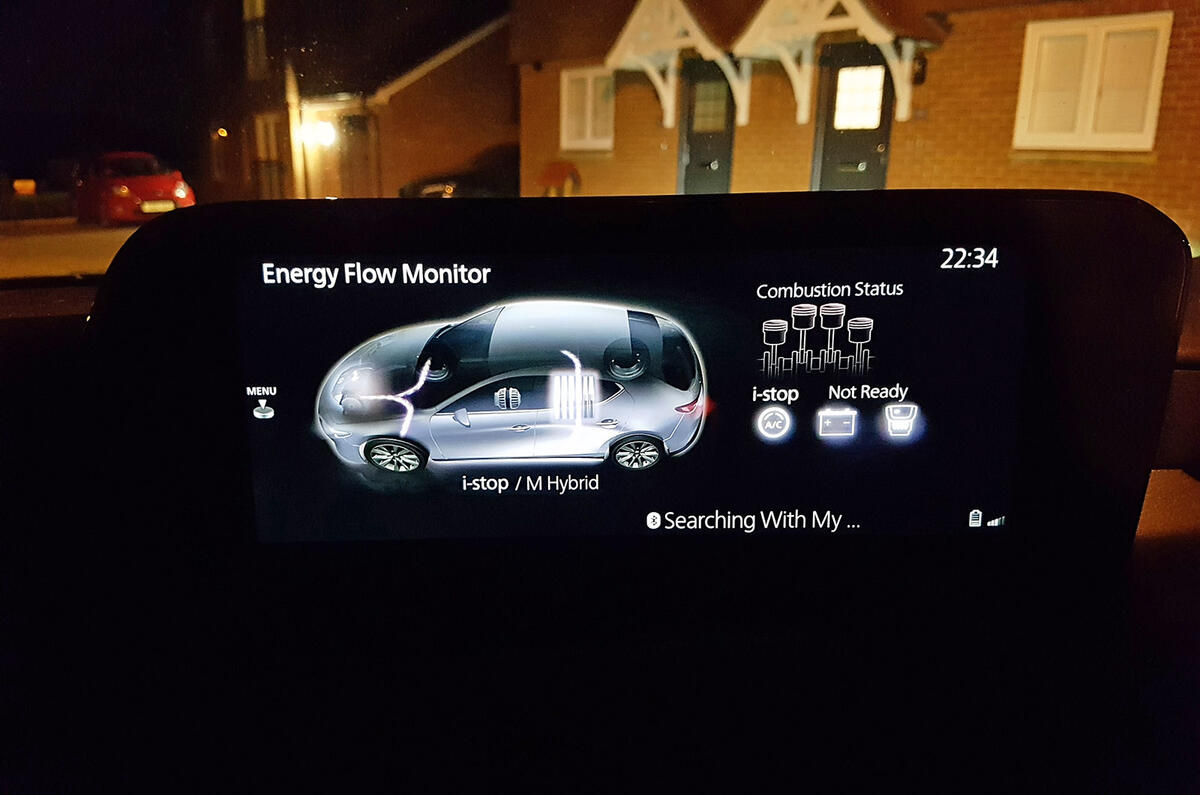
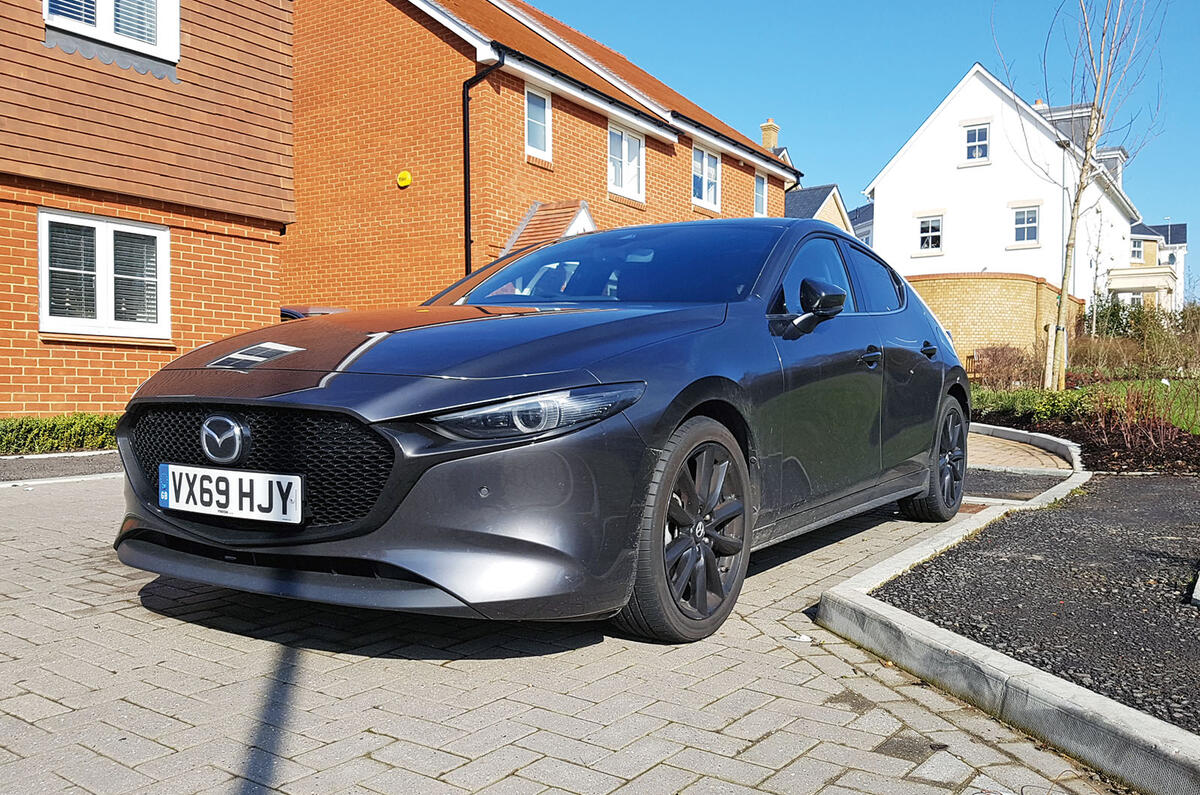
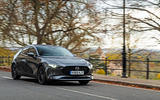
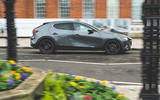
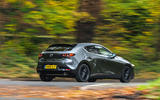

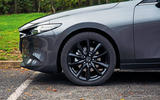
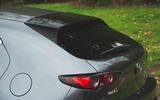
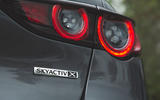
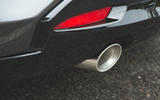


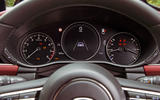

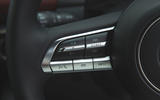
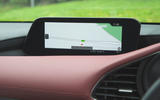
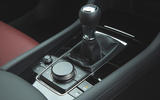
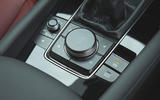
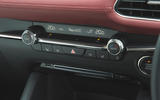
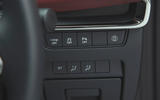
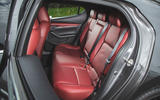

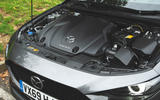
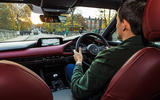
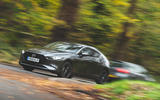
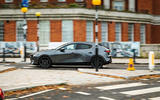
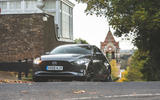
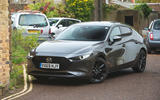
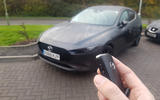

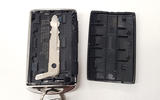
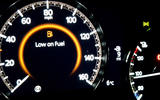
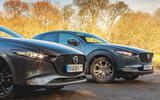
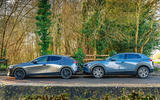

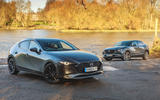
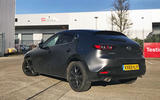
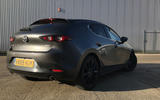

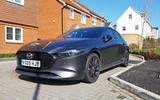


Join the debate
Add your comment
Don't get it
I've seen one in the metal (a neighbour's car) and I still don't get why people think it's particularly attractive - I think the Hyundai i30 Fastback looks much better for example.
Funny how this car is raved about in isolation - then when tested against competitors, always ends up at, or near, the bottom of the result rankings.
I'm sure a lot of buyers will
I'm sure a lot of buyers will be swayed towards the CX-30 just because they can see out of the thing.
Sub 30k coupe
Agree with your comments that this is the closest thing you can buy to something like a Scirocco now, in terms of style at least. I drive an Alfa Brera and I can't think of a single current equivalent. From the rear I think the 3 has a touch of Brera about it too.